CLICK HERE to sign up for our Newsletter!
call us 713-405-1193
call us 713-405-1193
Blog
Impromptu New York Trip During the Busiest Travel Week of the Year!
When I was growing up, my dad came to work in New York regularly to meet clients and visit the World Trade Center. Several times a year, he would turn it into a family vacation, and some of my favorite core memories are of clawing our way to the counter at a 1980s muffin shop, standing in the TKTS line in subzero temperatures, and scouring the countless shops on Orchard for the seamstress shop that produced Sherif bags.
One time, my mom got pickpocketed in Times Square, and we had to walk all the way across town to borrow money from my dad’s partner to pay for a cab to Greenwich Village. Another time, my dad got accosted by a bag lady for issuing a chipper “Good morning!” when she was in no mood for it. It was literally adventure after adventure. And my mom could not get enough of it.
She lived in New York from maybe 1963 to 1967, trying to make it on Broadway. While that never manifested, she had incredible experiences. She was in tons of shows and sang in mafioso nightclubs. The City became part of her identity, and through our many escapades around Manhattan, she made it part of mine, too.
We’ve brought Josephine to New York a few times in the past but never during the holiday season when New York shines the brightest – at least, not when she was old enough to remember. I’ve wanted to, but I just haven’t made the time. However, this year, I learned that Chess was playing on Broadway, and I immediately knew the time had come.
My mom and I saw Chess in Houston (I think we saw it several times) and then followed the production to see it again in New York. We had the soundtrack and sang the music constantly. The show itself became woven into our bond. And I knew that if it were playing on Broadway and she were alive, she’d waste no time in buying tickets and planning a trip to see it – even if she were mid chemo or directly post-op. I couldn’t let her down by missing this opportunity.
So we booked the entire trip about 8 days ahead of time, with just a few key activities besides Chess on the agenda:
1. Buy a Fornasetti plate at Bergdorf’s
2. Visit the Morgan Library
3. See the light show at Saks
4. Gawk at Christmas window setups
5. Dinner at Scalinatella
For everything else, we played it by ear, teaching Josephine that the beauty of Manhattan isn’t in planned activities but in spontaneity.
So here’s how it all played out:
Friday –
– Flight at 10:15, arriving at LaGuardia at 2:45PM. This felt a little early for the morning after Thanksgiving shenanigans, but we pulled it together, and I’m so glad we did! We were in our hotel room by 4:30 and eating hot dogs and pretzels by 5:00.
– We immediately walked out to see the hubbub of Fifth Avenue. We didn’t go into any stores; we just experienced the bustle of the street itself, including the exciting, sparkly windows at Bergdorf Goodman and the bright, musical extravaganza of the Saks storefront show. I remember seeing that for the first time with my parents about 7 years ago. Josephine was with us, but she was too small to appreciate it. My mom was a sucker for anything glitzy, and she was simply mesmerized by the spectacle. I could feel her with me this time, encouraging me to be just a little more wondrous and to encourage Josephine’s joy. It was wonderful.
– We were a little disappointed to learn that Rockefeller Center would not turn on the tree until December 3, but we did get to see the ice skating rink and promised ourselves we’d see the tree next year.
– We took Josephine to St. Patrick’s Cathedral, my mom’s favorite church in the city. Josephine did what my mom always did: she promptly bought a candle and lit it in front of the Virgin Mary. I know she said a prayer for my mom. Damn, we all miss her.
– Before we knew it, we were hurrying back to the hotel to change clothes for dinner at Scalinatella, one of my family’s favorite restaurants in the city. My mom and I happened upon Scalinatella one late night in the 90s. It was pouring rain at perhaps 9:30PM, and we couldn’t get a cab. We were starving, but we had no idea where to eat near 61st and 3rd; we were way outside our normal radius, and of course this was way before Google Maps or Yelp or Eater. So when we saw glass windows lined with wine bottles and felt a decidedly Italian vibe, we took a chance, opened the door, and descended a small staircase (a scalinatella, if you will) into the tiny dining room below. The restaurant was well into last call, and they could only make one thing: spaghetti al pomodoro, tossed tableside. It was one of the best meals I’ve ever had in my life, and we’ve been repeat customers ever since. But this was my first time to take Josephine, so I was way more excited than usual.
Fortunately, Scalinatella has never sacrificed the food and ambience that made our first night there so special. We sat amid Manhattanites, not a tourist to be seen, and we thought the guy at the table next to us was Aaron Sorkin, but we’ll never know. We ordered a ton of wonderful things, including zucchini blossoms stuffed with burrata and prosciutto, grilled baby octopus, spaghetti al pomodoro (of course), fettucine bolognese, snapper Livornese, grilled lamb chops, and a salad (you need your greens, you know!). True to form, Josephine tried it all, loved it, and walked home like a champ in the cold. See you next time, Scalinatella!
– We wrapped up the night with chocolate cake in the room. Josephine and Jamil watched Ace Ventura: Pet Detective while I sawed logs.
– What a full, wonderful first six hours in the city!

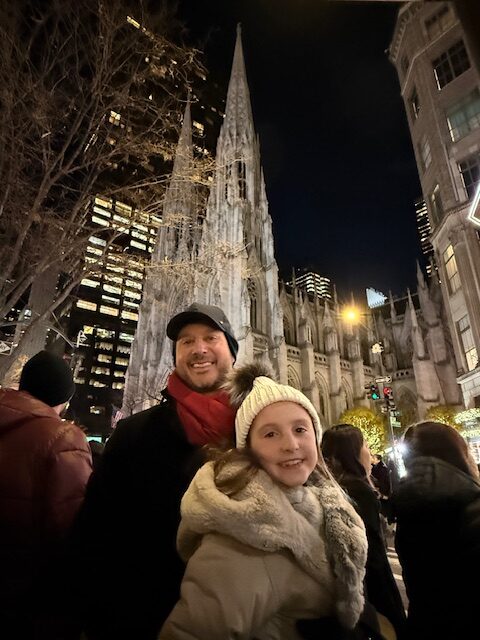
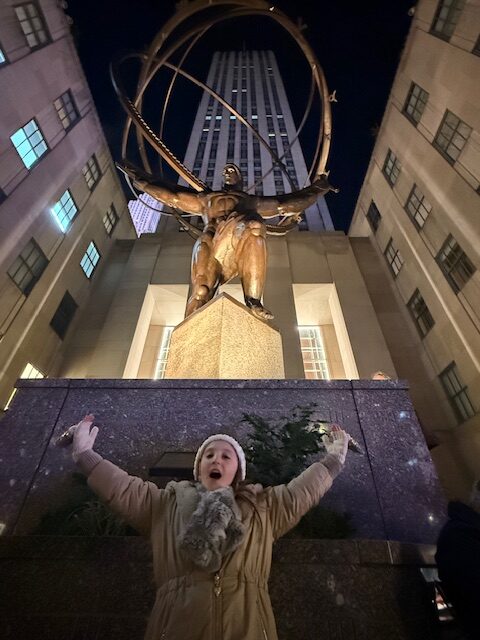
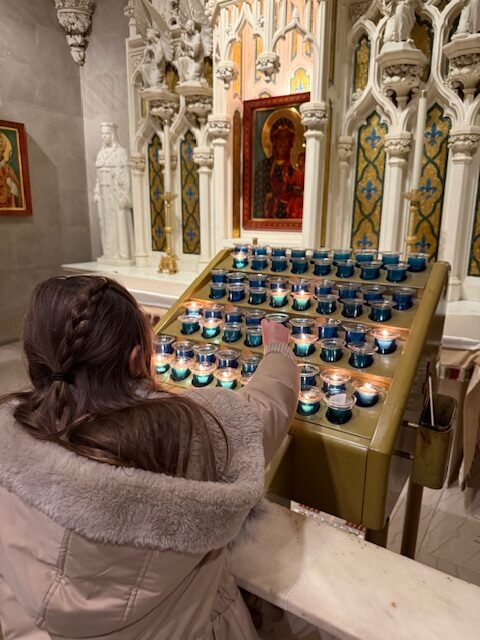
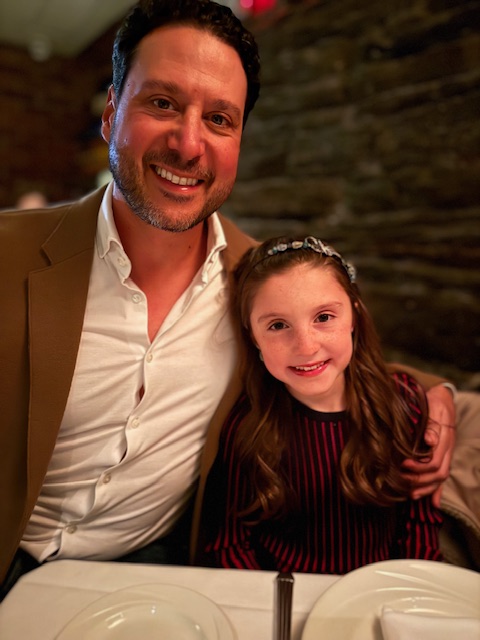

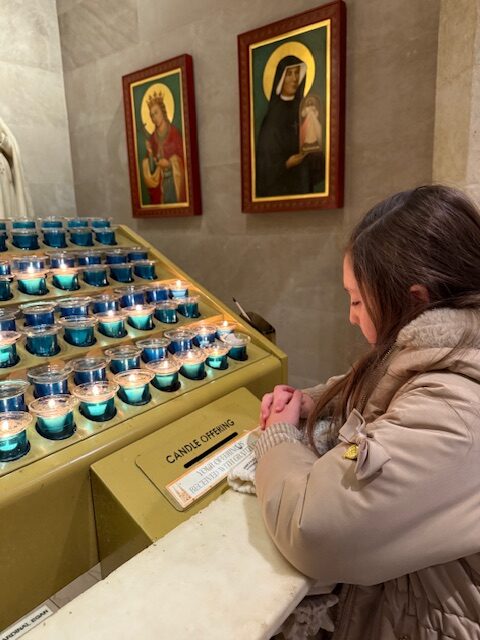
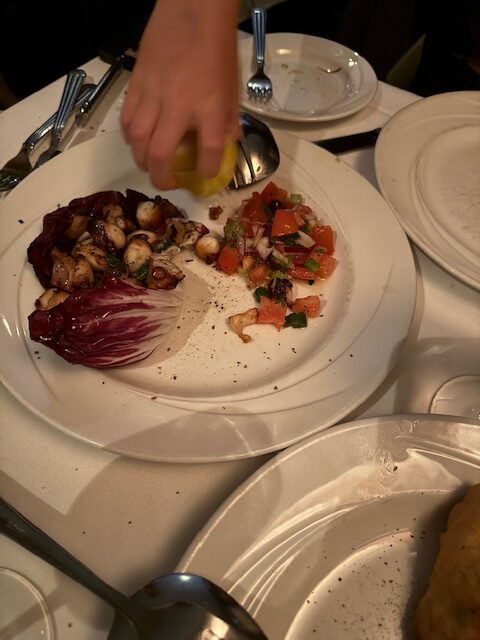



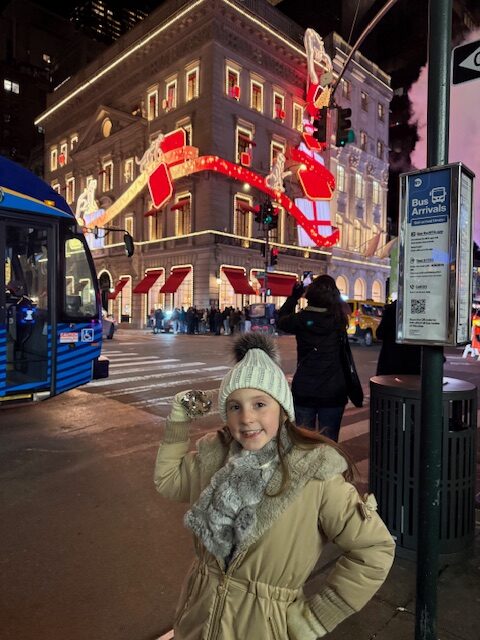

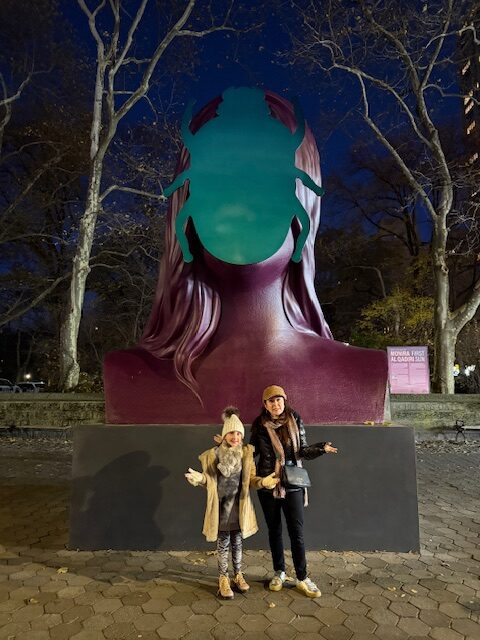
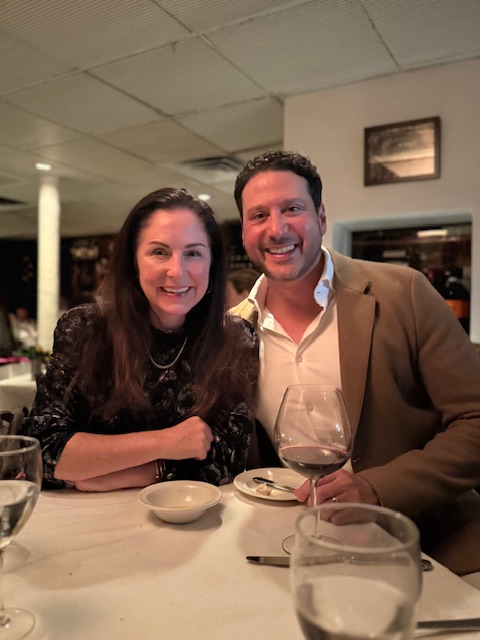

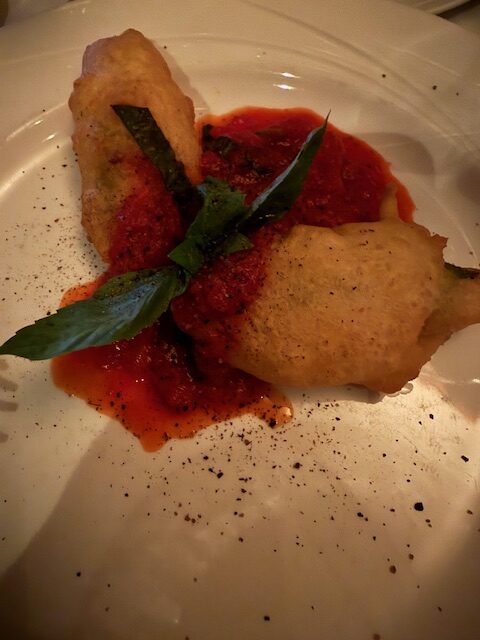
Saturday –
– We slept in a bit and let Josephine get a bagel and lox in the room. Then, we declared that it was time to scamp (that’s Jamil’s term for wandering around and just happening upon cool things to see and do).
– We walked down to the Morgan Library, founded by the descendants of J.P. Morgan to showcase the phenomenal acquisitions of that legendary banking tycoon. Morgan was an avid collector of all kinds of historical items, from ancient objects like tiny, cylindrical carvings, used to seal documents in Assyrian and Babylonian societies, to the Gutenberg Bible. We spent about an hour in the library, and we got lucky enough to crash a docent’s presentation about the library’s literary collection. The next time we go, I’ll make sure we join one of those tours. I cannot wait to go back.
– From there, we meandered over to the heavily Asian area around Broadway and 39th to look for Korean skincare products. Along the way, we stopped for (subpar) ramen at Nishida and got Josephine a (fabulous) matcha parfait at Nana’s. Then, we took Josephine to Macy’s, just so she could see the madness of that New York institution during the holidays. It was indeed crazy.
– Then, we started our trek back to the hotel to get ready for the event that prompted our trip in the first place, Chess at 7:30PM. Josephine is such a good sport about walking on our trips. She puts in thousands of steps a day and rarely complains. It’s amazing to have brought a true companion into this world.
– Chess was good. The performers had incredible voices, and the music was great. However, someone played Frankenstein with the storyline, and it’s just too contrived. It already required the suspension of disbelief, but this went too far. I won’t see it again. But Josephine was a great sport, as usual – always happy to see a musical. Really, any musical.
– We closed out the night at Avra Estiatorio off Madison and 61st. We’ve been there for late-night dining before, and it’s a great post-theatre option. The Greek cuisine is pretty authentic and mostly good. The grilled halloumi is great, served with honey and citrus. The grilled calamari are the best around; it’s thick, well-seasoned, and not too chewy. The hummus leaves a little to be desired. It’s pretty flavorless. But then again, a lot of hummus rests too heavily on the chickpeas for flavor, when they’re bland as all get-out. Sadly, we had to do this dinner without Josephine, for the most part. She drank part of a mocktail, ate a piece of pita, and then put her head in my lap to snooze until the check came. But that was also pretty sweet and nostalgic. I love her so much.
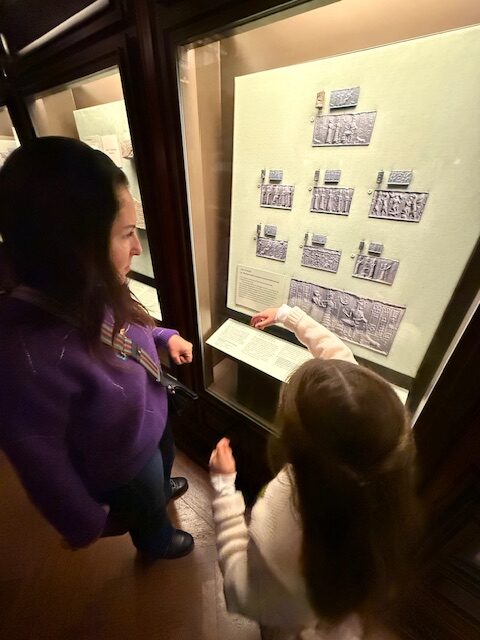
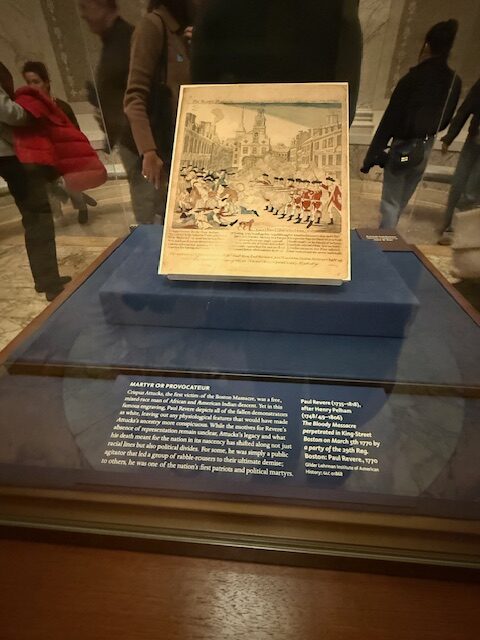


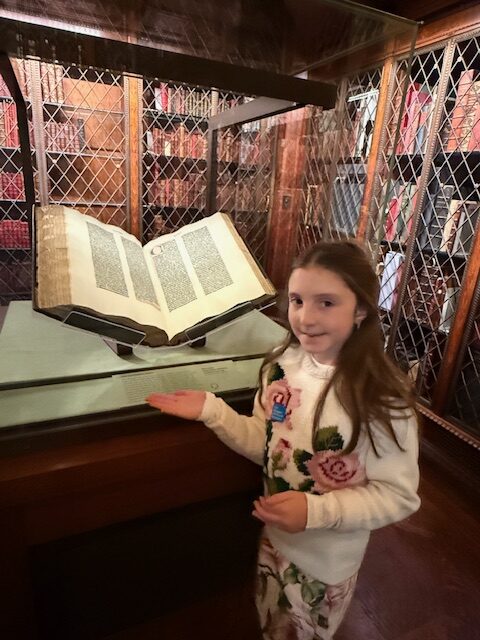

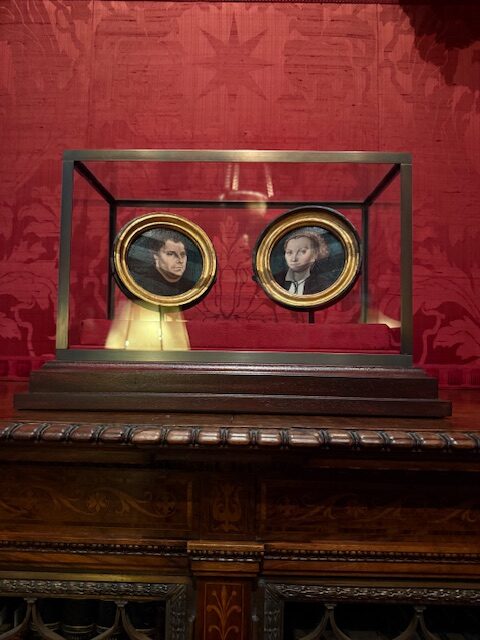

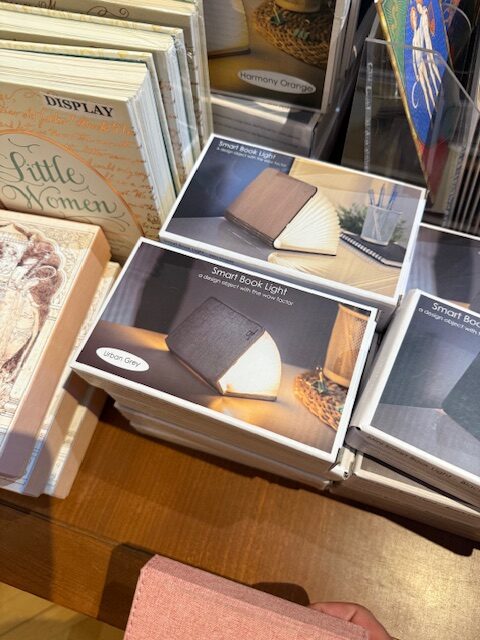


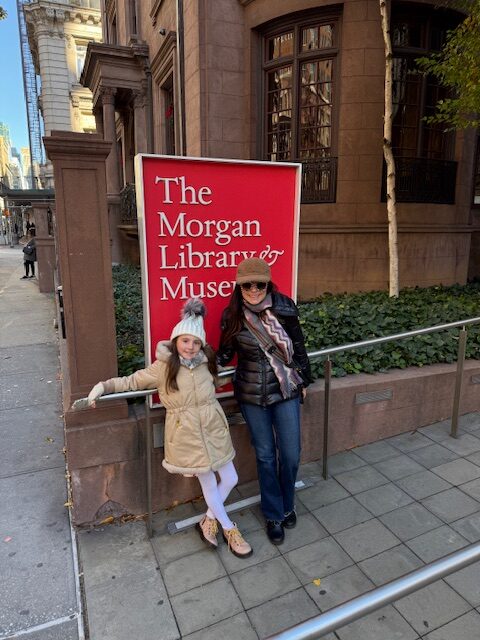



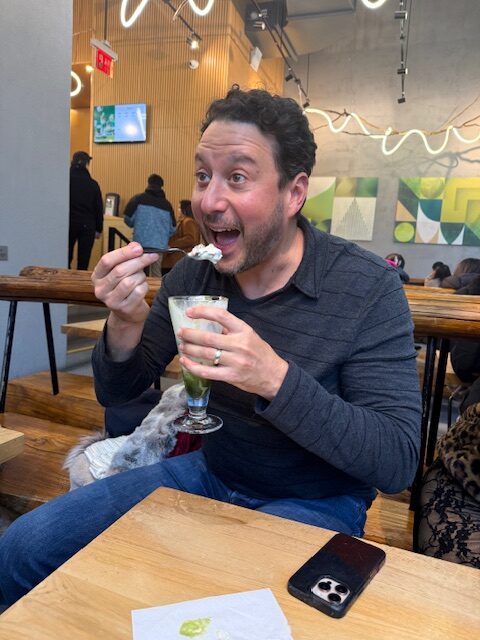
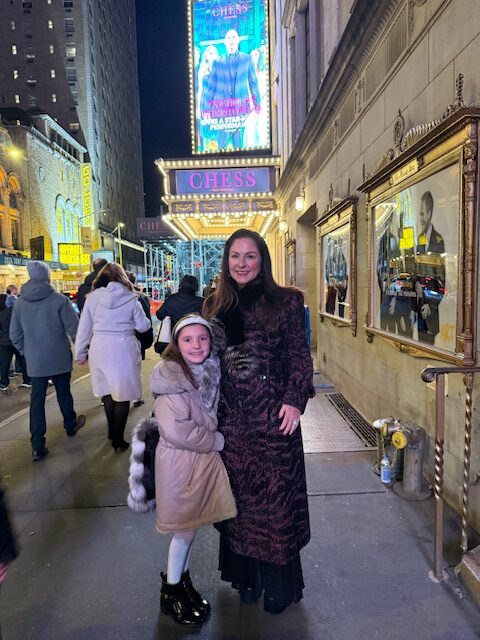
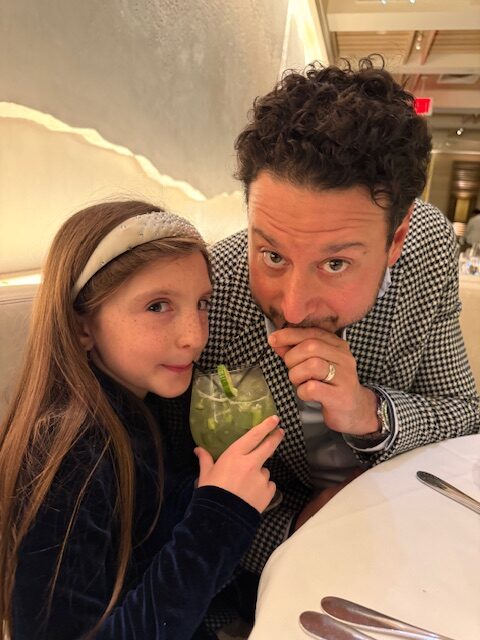

Sunday –
– This was really my shopping day to buy a crazy Fornasetti piece to put in the corner of my kitchen. The best selection I’ve seen is on the top floor at Bergdorf’s, so that was at the top of the agenda. Josephine was appalled by the surrealistic imagery that put Fornasetti on the map. She begged us not to buy the clock that ultimately called our name, but Jamil and I reminded her that our home is filled with “weird” art. It’s what we love. Eventually, she’ll love it, too!
– As much as she disliked the Fornasetti, she was obsessed with the Christmas decorations that filled the whole store, especially the top floor, where there were all kinds of crazy Christmas trees and ornaments and gigantic peacocks. We let her pick out some ornaments for the tree at home, and we gawked at the ridiculously expensive Christmas trees made out of antique brooches, watch faces, and bracelets. It was so fun.
– Finally, it was time to have lunch and head to the airport. We stopped into La Goulue, a French bistro right next to our hotel. Jamil had French onion soup with a Caesar salad, while Josephine got the potato and leek velouté with a butter lettuce and chive salad. We all split the mussels, which were so fresh and delicious, I could have eaten the entire order myself.
– And before we knew it, we were in a Blacklane car on the way to catch our plane, fighting traffic and arguing with police officers who were blocking the way to Terminal A at Newark. It was chaos, and Jamil hopped out to print the luggage tags before the window to check bags closed. But we slid through security with Clear and made it to the gate with time to spare. I love that kind of chaos.
This trip was so amazing that all three of us want to make this a regular affair. We’ll see if we can pull it off. But I came to New York several times a year when I was Josephine’s age. I’d love to give her that same opportunity. Now, granted, I didn’t go to Europe and Asia and Florida and you-name-it, like she does. And there’s only so much time in a year. But as her schedule gets tighter because of activities and academics, maybe we’ll find ourselves in Manhattan more than other places. Who knows, but I’m looking forward to it.

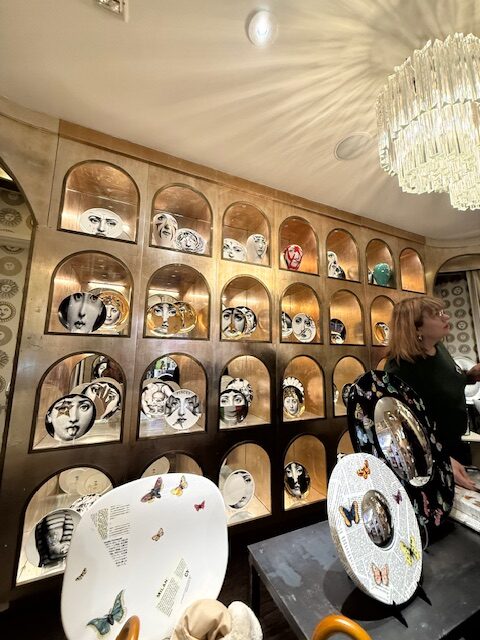
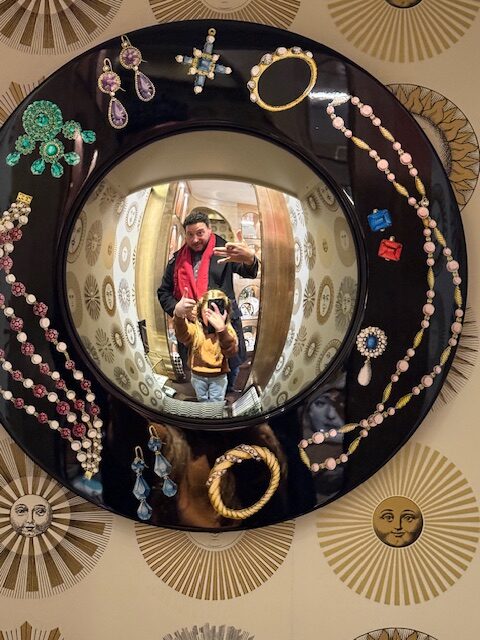
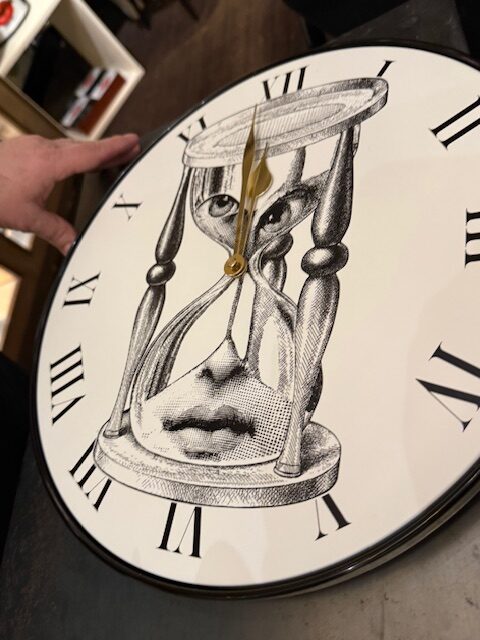
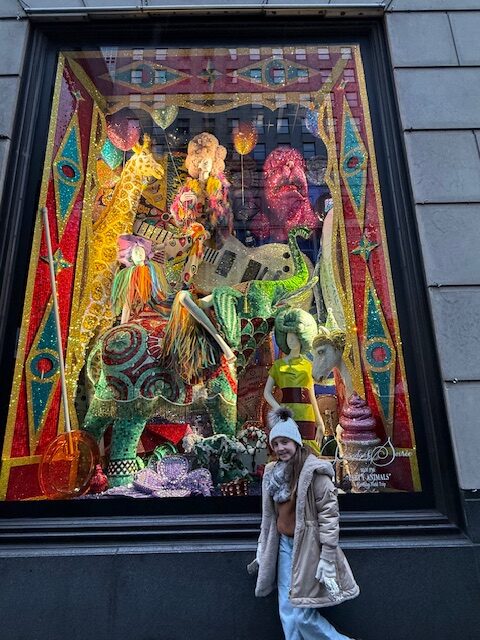



The Abrasions of Travel – Resiliency on a Road Trip
Josephine goes to camp in North Carolina, and this summer, we decided to drive there from 30A in Florida. My business partner and close friend, Beth, sends her daughter to the same camp, so we planned to make the easy 8-hour drive together.
A Rocky Start
We got off to a bit of a rocky start – Jamil and Julie left for the airport with the car key, and Jamil had to pay the Uber driver to bring it back to us. But we still had a lovely first day, topped off with a great evening with my cousin and her family in Atlanta. And we set out on Day Two full of excitement for a couple of fun nights in Asheville.
Starbucks Detour
It’s only about three hours from Atlanta to Asheville – easy-peasy by comparison to the five-plus-hour trek the day before. So when Josephine and Nellie said they’d love a snack and a Frappuccino from Starbucks, Beth and I were more than happy to oblige.
I figured the Starbucks indicated on the roadside sign would be in a shopping center near the highway, so I pulled into the closest strip mall. The Starbucks wasn’t there. In fact, the entire strip center was under construction. I did a little turn around in the parking lot and made my way back to the main road to find the promised coffee shop. We had to drive quite a while before we found it, and when we pulled into the parking lot, we were all ready for refreshments.
The Flat Tire
As Josephine got out of the backseat, she said, “Hey Mom, there’s a hole in your tire.” I thought she was joking or maybe misinterpreted something on the tire, but I went around to check anyway. Turns out, I shouldn’t have underestimated her. There was not only a hole; there was a GAPING hole that was spewing air like I’ve never really seen before. I knew it was only a matter of time before we hit zero PSI and would be driving on the rim.
Beth and I ordered the girls back into the car and immediately started brainstorming a solution. Fortunately, it was 2PM on a Saturday, and we were in a reasonably populated area. There had to be an open tire shop nearby, so we started driving in the direction that looked more densely commercial on Google Maps.
Finding Help
The first place I called was basically useless, but at the second place, Mavis Tires, the nicest guy answered the phone. I explained that my father had tried on many occasions to teach me how to change a tire, but my lack of size and strength made that an unlikely feat for me. I couldn’t lift the spare, much less use the jack effectively.
Out of the goodness of his heart, he told me to sit tight. He’d be there right away to save the day. We pulled over into the entrance of a rather beautiful retirement community to wait for our knight in shining armor.
At the Shop
Soon enough, Jerry from Mavis arrived and pumped our tire up enough for us to scurry over to the shop. Before we knew it, the car was suspended in the garage, getting THREE new tires, an oil change, and an alignment. We used that time to have a little picnic at the Publix grocery store that was just a little walk away. Sweet Jerry offered to let us drive his truck to go elsewhere, but we felt like the simple pleasure of impromptu charcuterie and pretzels was actually pretty special.
Lessons in Resiliency
In the end, the abrasions of travel made the drive way more memorable than it would have been otherwise. It was fun. And it was a learning experience for our girls. They got to see us roll with the punches. We didn’t get stressed out or angry. We found solutions and made the most of a potentially unpleasant situation. I think the girls will remember the way we handled the unexpected hiccup, and I feel confident they’ll keep their chins up and find a way to make lemonade out of their lemons.






The Road Trip from Prague to Budapest
I love driving in Europe. It’s the best way to see towns and people in action, and it gives you the chance to stop at corner stores to check out local potato chip flavors.
Typically, we rent a car. I do the driving. Jamil does the navigating. Josephine does the complaining. Harmony.
This time, however, we didn’t rent a car to go from Prague to Budapest because the drop fee for renting a car in the Czech Republic and returning it in Hungary cost more than hiring a driver.
I was reluctant to relinquish the driver’s seat, but I’m SOOOO glad I did! The driver, named Martin, contracted through Sidetrip Tours, turned out to be an amazing guide. We learned more than we ever could have without him.
One reason I wanted to drive was that I wanted to take Josephine to Kutna Hora, a small town about an hour outside Prague. Kutna Hora is best known today for its phenomenal bone church, called Sedlec Ossuary.
In the 13th century, the abbot of the Sedlec monastery traveled to the Holy Land, and he returned with a jar of Holy Soil, which he spread around the cemetery. Word spread about the hallowed ground in the Sedlec cemetery, and people from far and wide chose to be buried there – way more people than Sedlec could accommodate.
As you might guess, the bones piled up and up and up, until about 150 years ago, when the church decided to organize the remains of the 40,000 people that had accumulated in the ossuary. In the process, someone decided to get artsy, and today, the ossuary at Kutna Hora is the world’s most impressive array of human bones, formed into chandeliers and beautiful stacks and family crests. It’s fascinating.
Jamil and I traveled to Kutna Hora in 2009 when we were planning our wedding. Back then, you could take pictures. The days of social media put an end to that type of photographic freedom, though. I can just imagine how many influencers were posing in front of sacred human remains for the perfect shot! In any case, that’s why my photos of the experience this time are so limited. And it’s even cooler today than it was when Jamil and I last visited because they’ve done such a phenomenal job cleaning the bones and the ossuary to make it glistening white. I couldn’t take any pictures to prove it, though! You’ll have to make do with these gems from 2009.
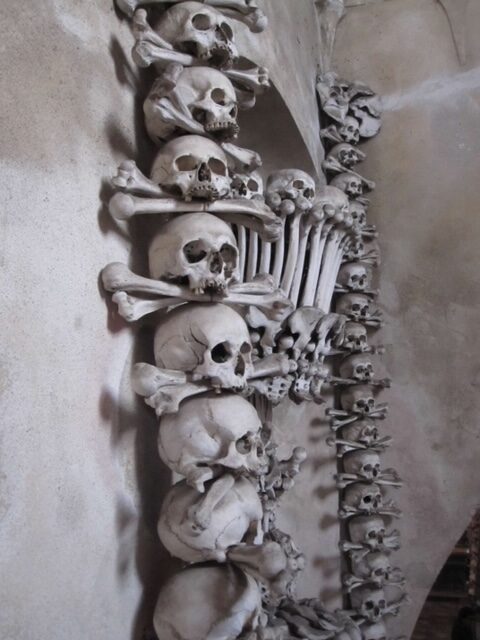
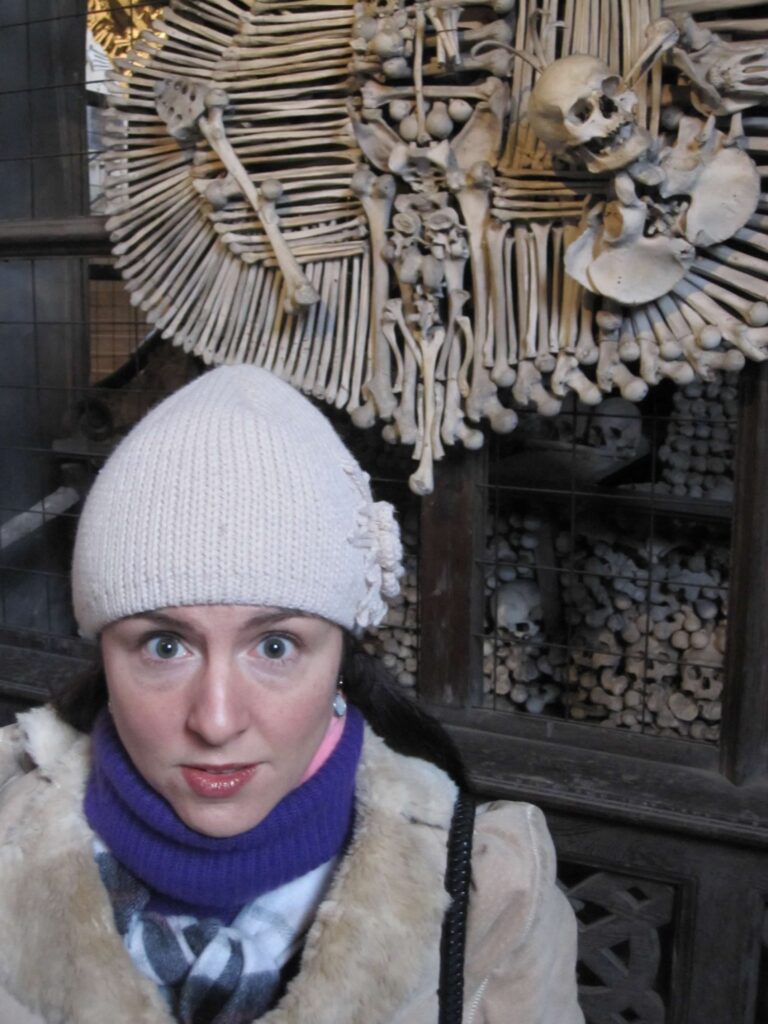

If you go to Kutna Hora, you should also stop into the Lego store right near the church. They’ve used Legos to make recreations of skeletons and other ossuary-appropriate designs. It’s funny.
After Kutna Hora, we drove to Bratislava for our first (and likely only) visit to Slovakia. We were lucky to catch the last night of the Christmas market in Bratislava. While it didn’t have any amazing activities, the market had, by far, the most interesting street food we saw throughout our trip. They had a stand specializing in homemade Slovakian pasta, which came with somewhat shocking accoutrements, like poppyseed or nuts and jam or bacon, sauerkraut, and onion. They had a stand, serving what I can only call a riff on a burrito – basically giant flour tortillas, stuffed with sauerkraut or cheese or chicken liver and rolled like cigars. They had stands with unusual sausages, served with spicy peppers and sautéed onions along with Slovakian sauerkraut soup. Literally, the options were endless and nothing like I’d seen before. So, we were only there for an hour or so, but the detour was well worth the effort.
I should mention here that Martin, our driver, never stopped sharing interesting historical details about the countryside, the cities, and the people who inhabit them. We learned many tidbits on that drive, and we got to hear about his life during the Cold War. He had an unusual situation, in that his father worked for a company that conducted international business, which allowed Martin and his family to travel all over the West, visiting the United States, the UK, and other countries that his classmates could only dream of seeing. It was cool to talk to someone who lived through the darkest times of the Cold War, only to emerge on the other side and go on to work in entertainment. Imagine how much his world has changed in the last thirty years! From zero tourism in Prague to hordes of wander lusters clogging its streets. That’s given him such a unique perspective that I can’t wait to hire him again. And if you have any desire to get in touch with him, please let me know.
We rolled into Budapest late in the evening, probably around 7PM, with just enough time to get changed and headed out for dinner. As we drove into town, Martin gave us an introduction to the city, describing the differences between Buda and Pest, the two sister municipalities on either side of the Danube. Budapest by night is quite dramatic, I must say… We got out of that car completely jazzed to explore its glamour, and we were so glad we’d taken the long way to Budapest. It was entertaining, to say the least.
Eating in Prague When You Only Have 36 Hours
One interesting thing about restaurants in Prague is that they’re open late by comparison to restaurants in other northern European places we’ve visited. It’s common for people to eat dinner at 8:30 or 9:00, which is great for us after a day of sightseeing, when we want to relax and shower before heading out to eat.
1. Kampa Park
Kampa Park is special. My parents ate there during their last trip to the city, and my mom told me it was wonderful. It really is.
First, the location is crazy. It’s right down on the Vltava River, and apparently, with enough notice, they’ll give you a boat ride before dinner. We sat down in the heated, glassed-in patio along the water. Josephine thought it was amazing that they gave each of us a blanket to wrap around our shoulders or legs for extra warmth.
Second, the food is tremendous. We ordered the creamiest burrata with vegetable caponata and amazing salmon sashimi with ponzu, garlic, ginger, and sesame. Then, Josephine ordered a simple risotto, while Jamil got the miso-marinated salmon with wasabi-green pea puree, and I got grilled octopus. Every dish was cooked to perfection.
Third, the service was so kind! We were the last people at the restaurant by quite a while. But no one hurried us. They wanted us to enjoy the experience, and we really did.
2. V Zatisi
Jamil and I fell in love with this restaurant in 2010, so much so that we decided to have our wedding dinner here. Despite COVID and all of the chaos of the past 15 years, Zatisi has somehow stayed successful, popular, and relevant. It’s still just as attractive and lovely as it was the first time we sat down for a meal there.
We tried an array of dishes, but what stood out the most were: (1) Beef Tartare with black garlic and truffles; (2) Veal Wellington with jamón serrano and potatoes; and (3) Pike Perch with carrots and cabbage. If we’d gotten there earlier, we might have ordered a tasting menu, but honestly, that’s not really Josephine’s style. She can’t eat that much to begin with, and she doesn’t want to be steamrolled into eating something she isn’t ready to try. Come on, this child has such a varied palate. It doesn’t make any sense to torture her!
In every way, it was special to share with Josephine the place where we had that wonderful meal. Our wedding left an indelible impression on the people who attended. It was so intimate and special. I’m glad that Zatisi has stood the test of time, so we could relive the experience with the person who’s the product of the union we celebrated all those years ago.
3. Lobkowicz Palace Café
We were hungry after walking around the Castle, but I didn’t know where to get anything decent to eat in Tourist Central. Then, I looked up and saw the Lobkowicz Palace sign, which also offered food at a café. I confidently told Jamil we should make a stop.
As I expected, the Lobkowicz Café was a perfect place for us to get a quick lunch. We got fresh cabbage soup (the Soup of the Day), warm lentil salad, and a grilled ham & cheese sandwich. There was nothing fancy about the food, but it was fresh and clean. And there was a terrace with a beautiful view of the city. It was too cold to sit out there, but perfect for a picture!
And if you’re in Prague with adults and/or older children, make the Lobkowicz Palace Museum the top stop on your list. The exhibits are phenomenal, but you are missing out if you see them without listening to the fantastic audioguide. I didn’t really think Josephine was up to it; there was so much WWI and WWII history involved that I figured it would be confusing. However, the next time we go, we’ll do it. I think she’ll be just as floored as we were on our last visits there.
Prague in a Split Second
Our intended flight to Prague would have gotten us in around 1PM. We figured we would have that day to explore the Mala Strana (or Old Town). Then, we could spend the next day at the Prague Castle. However, the universe had other plans, as we learned when they canceled our flight while we were waiting in line to check our bags. That left us with just enough time for dinner on our first night in Prague and a full day of exploration on our second. It wasn’t enough to see all of Prague’s glory, but that’s okay. There really wasn’t a better place for things to work out exactly as they did.
Jamil and I got married in Prague in 2010, and we’ve had the chance to wander the city’s nooks and crannies, both on our own and with a guide. Prague is a fabulous, historic city with a complicated history, really too complicated for Josephine to understand at eight years old. Prague is somewhere we’d have to revisit under any circumstances to give her a fair shake at grasping the city’s significance. And the little time we had there successfully whetted her appetite; she loved it and can’t wait to return.
Here’s what we did in the short time we had:
1. First, a walk through the Old Town.
Luckily, the Christmas Market was still in full effect. It was so lively and fun, and we couldn’t help but stop for an early-morning cup of hot chocolate that boldly proclaimed itself, “The Best Hot Chocolate in the World.” That was too tempting. We had to find out if it was true. And it was!
We also walked over to the famous Orloj, the medieval astronomical clock that is attached to Prague’s Old Town Hall. The clock is mesmerizing. The clock was created in 1410. It shows the rotation of the zodiac, reflecting the Sun’s location and the Moon’s, as well as tells the time. And it has these magnificent figures that move around the clock every hour, representing Greed, Vanity, Death, and Lust. Furthermore, the Twelve Apostles appear on the hour. So people tend to stand and wait for the hour to strike, so they can watch the Orloj do its thing.
The clock has particular significance to us because my parents were sitting in the square, having a glass of wine and admiring the clock’s design, when they struck up a conversation with the Portuguese gentleman at the next table. They talked and talked, and eventually exchanged contact information. He turned out to be the Minister of Energy for Portugal, and would you believe that we wound up connecting with his family in Portugal not once, but twice? We would call them again if we went to Lisbon, and I hope they’d call us if their paths led them to Houston.
2. Shopping at the Moser store in the Old Town.
This year, I couldn’t think of anything I wanted for Christmas. What I really wanted was to go to Europe and shop for beautiful things. One thing I’d been pondering was purchasing new crystal glassware. Jamil and I adore having friends over for drinks and dinner; it only makes sense that we should invest in some pretty pieces to serve our guests.
Moser Crystal is spectacular. The company has been producing intricately engraved glassware for almost 200 years. It has supplied crystal to the monarchs of Austria-Hungary, Persia, England, the Vatican, and so many others. And when you visit the Moser store in Prague, you can feel how special the pieces are.
The Moser store is set in an old palatial home that has original, highly detailed wood paneling and wonderfully tall ceilings. The pieces are on display behind glass, for the most part, lest a clumsy customer shatter a work of art.
Jamil and I found a pattern we loved, and we purchased several glasses to send back to the United States. We intend to buy more over time and eventually complete the collection. I will look at them forever and think of this precious time together with our amazing daughter.
When my mother died, I learned that you can only hold onto so much. Maybe these glasses will be among the heirlooms Josephine chooses to add to her own collection when we’re gone.
3. Walk across Charles Bridge to Prague Castle
The Charles Bridge dates to 1357. It’s lined with 30 baroque statues, and while conservationists argue that renovations of Charles Bridge have been shoddy throughout history, ignorance is bliss. It looks great to me!
It was snowing as we made our way across the bridge, a phenomenon that made a beautiful landmark even more breathtaking. As Josephine pointed out, the snow created a sort of reverse shadow, covering all of the crevices with white. It was so special.
If you go, don’t forget to rub the dog on the St. John of Nepomuk statue. It will bring you good luck! And you should have no trouble finding the exact spot to rub: unlike the majority of the bronze on the bridge, which has darkened from oxidation and pollution, the lucky spots are bright, shiny gold because so many people rub them every day.
4. Prague Castle
Prague Castle is the largest surviving medieval castle. Construction started in the 800s! It housed monarchs of Bohemia and the Holy Roman Empire; it served as the seat of the Czech Republic. And for centuries, people have been coming to the Castle to worship at its awe-inspiring basilicas.
The Basilica of St. Vitus dates to 1344. It was a medieval pilgrimage site because it held (and still holds) the remains of St. Wenceslaus, and it’s one of the few churches in the region that came through WWII intact. There are countless elements of the church that make it worth a visit, but I particularly like the wooden relief carving of Prague from 1630 and the Mosaic of the Last Judgment on the exterior wall of the basilica.
We also visited the Basilica of St. George, which is the oldest building in Prague Castle. Honestly, I know the basilica is important, but it’s worth only a brief look. It’s very simple, which is unsurprising, given its age. The coolest thing about the church is that it holds the remains of some saints, most notably Ludmila of Bohemia, the grandmother of Wenceslaus. She was strangled to death for her commitment to Christianity, so she had a one-way ticket to martyrdom and canonization. She’s considered a patron saint of the region.
The Lobkowicz Palace, the most fabulous, intimate museum ever, is also in Prague Castle, but we opted not to tour the exhibits this time. The last time I was there, I spent upwards of 2 hours, listening to the audio guide and studying each exhibit. I didn’t think Josephine was really ready for that, so we didn’t do it. However, you should know that the Lobkowicz family is really in charge of the Palace. They run the entire operation, and everything is top-notch. We met the family when we were there in 2010, and then by some weird coincidence, one of our clients happened to be closely related to them! They’re committed to the legacy of the Lobkowicz name, so you won’t be disappointed by any of their ventures.
5. The Mozart Interactive Museum
This was a nice museum. It’s huge, set over four floors, and the creators put a lot of effort into making the space fun and educational. For example, they laid out in order from smallest to largest a violin, a viola, a cello, and the like. As you opened the instruments, they began to play their portions of the melody. When you closed the boxes, they stopped playing. You could play any combination of them, and it was very cool. We all liked learning how the various stringed instruments contribute to the sound of a piece. They also had a virtual reality conducting experience and a room where you could spin various cylinders that repressed instruments to make the sounds of those instruments come alive. And throughout the exhibits, they offered insights into Mozart’s life and genius. It was a good way to pass some time and encourage musical interest, if a little cheesy here and there.
6. The Museum of Alchemists and the Ghost Museum
This was not a museum I longed to see. But the ticket was included with another ticket, and we were like, hmmm, why not? Turns out, there are many reasons why not, but it was still better than the Ghost Museum, described below.
The Alchemist Museum is filled with all kinds of garbage, but it does take you up an interesting staircase that the guides say is hundreds of years old. I believed them until I went to the Ghost Museum, which was such a piece of grunge that it made me doubt anything they had to say. We climbed into the attic of a building that was five centuries old and viewed ridiculous installations meant to teach us what alchemists were really into — attempting to grow humans in soil, for example. There were strange taxidermies and bizarre mannequins. Honestly, I’m glad we went because it was THAT weird.
The same cannot be said of the Ghost Museum, which Josephine insisted on touring. Man, Prague has a weak-sauce history of hauntings, or at least they’re presented wretchedly in this ghost museum.

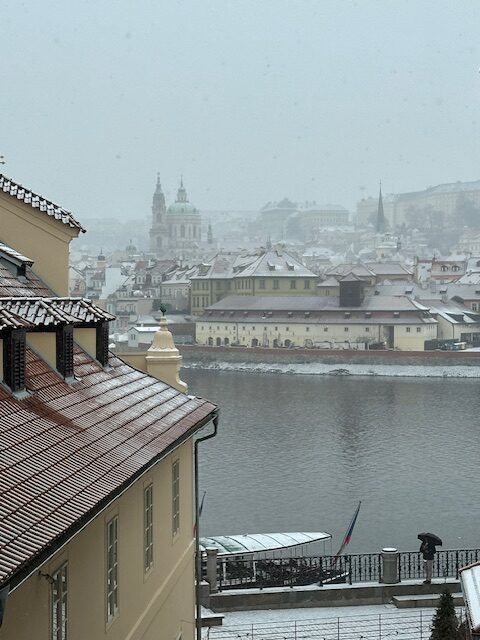


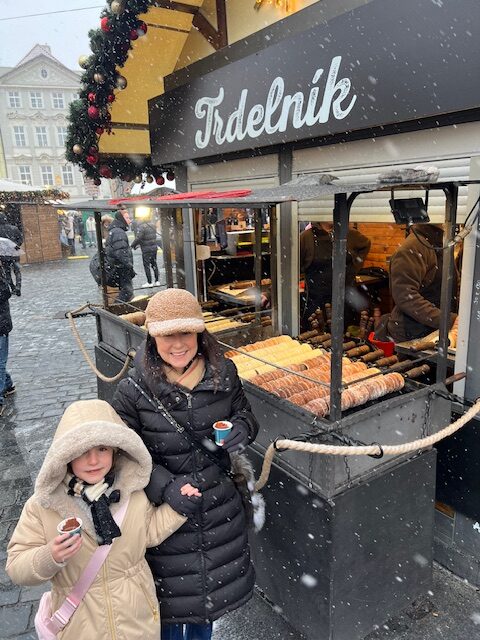
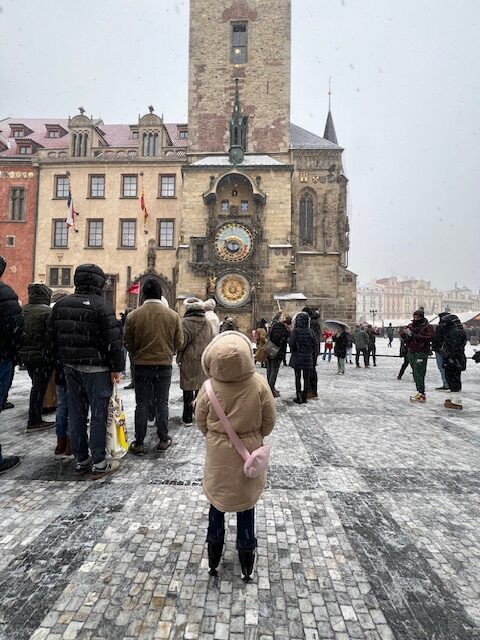
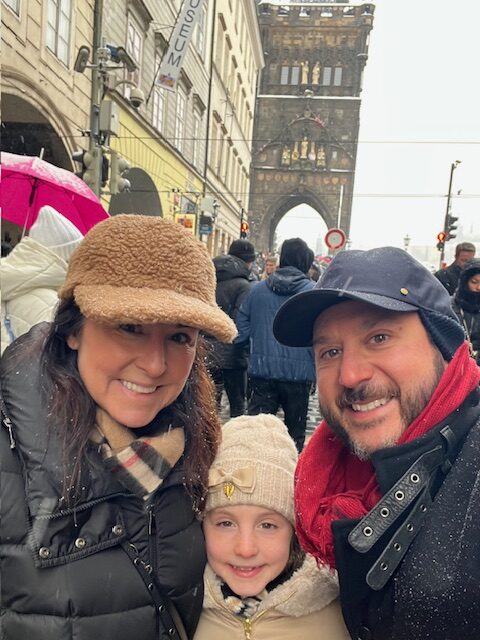

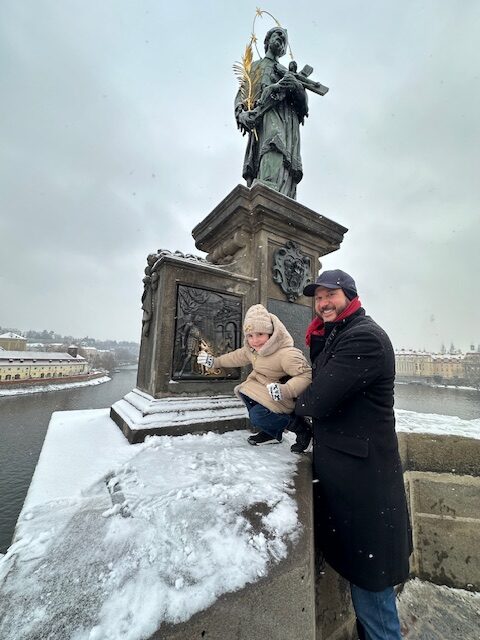
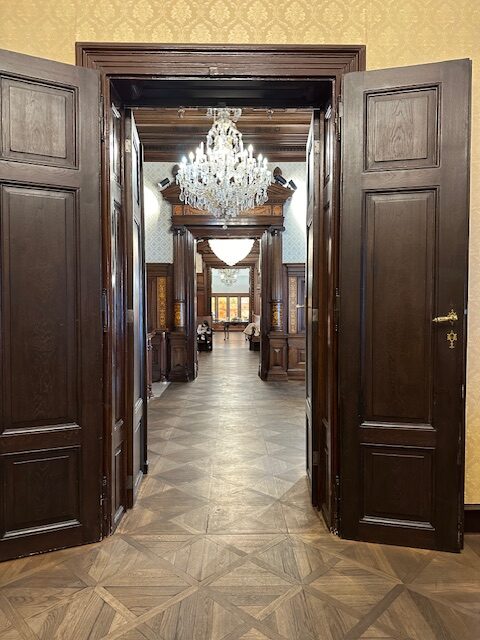
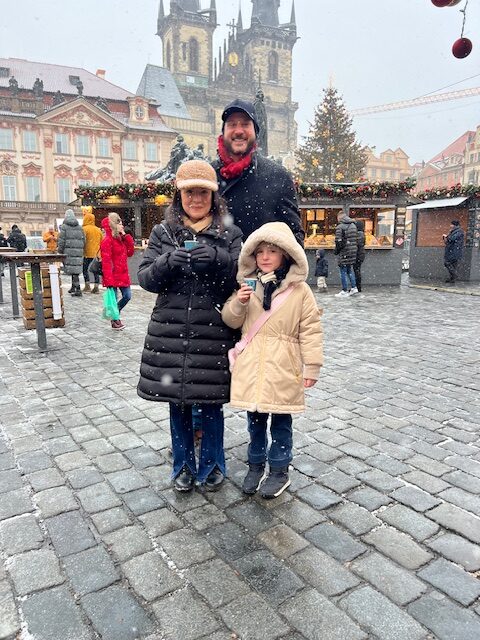

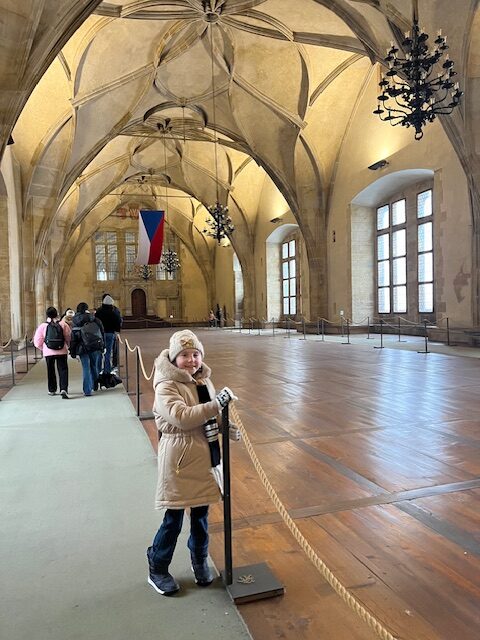

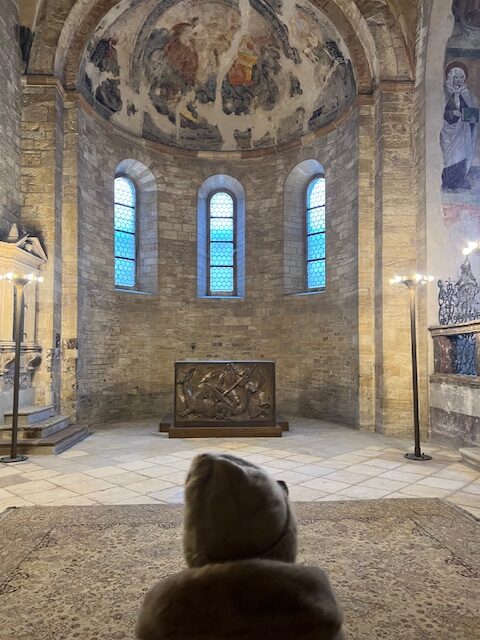
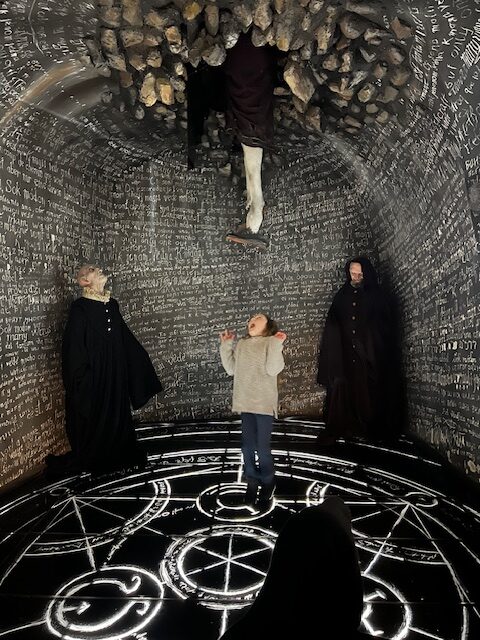

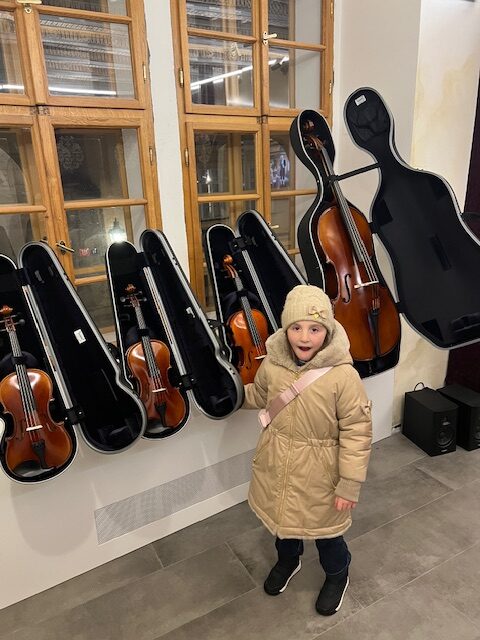
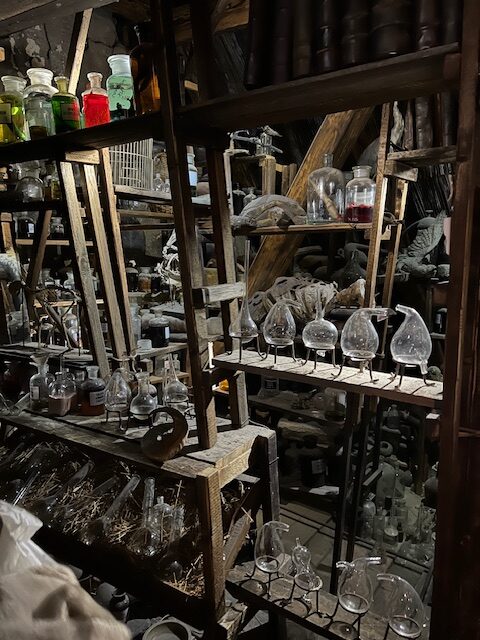

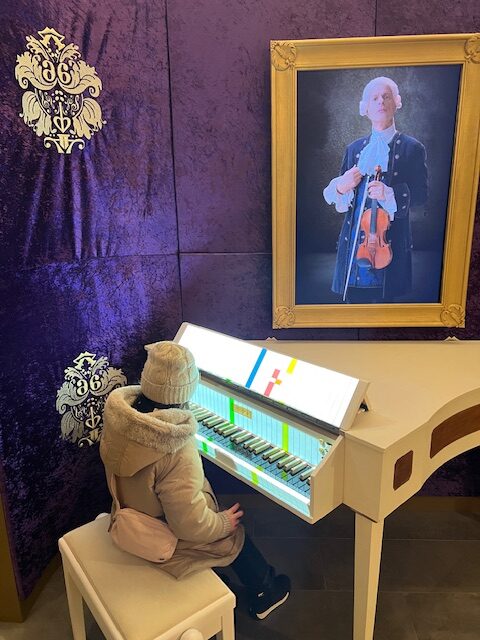
Breakfast and Lunch in Spain
I’m not much of a breakfast eater, but if there’s one place that can convince me to forgo my intermittent fasting for a day, it’s Spain.
Traditionally, the Spaniards don’t do bacon and eggs or French toast or yogurt with granola (although you can find pretty much anything you want in most cities these days). Instead, breakfast in Spain is a small affair, either a simple pastry or a small loaf of toasted bread, served with freshly grated tomato, olive oil, and salt.
You can get it at basically any bar in the city. Yes, I said bar. All the tapas bars open in the morning for coffee and barritas de pan con tomate. Alternatively, you can run into any one of the many bakeries situated all over every town. You’ll get the same fare, albeit with a greater array of pastries to choose from.
We typically go to the same bakery every morning in Madrid. It’s called Granier, and it’s located on Calle Hermosilla. I can’t say it’s the world’s greatest bakery. It doesn’t have to be. All we need is a decent croissant for Josephine, good café doble (double espresso), and fresh bread and tomato. It’s wholly satisfying, costs perhaps $10 total for all three of us, and takes approximately 15 minutes.
Now, onto lunch!
Referred to as comida, lunch is the main meal in Spain. I’m not usually the biggest lunch person, but in Spain, we walk a ton, and I’m very hungry by 2:30, a solid lunchtime over there.
On this past trip, I have to say that our lunches were pretty weak. The first day we had in Madrid, Jamil flew to London and back in an attempt to retrieve our bags. Josephine and I had our small breakfast at Granier, thinking Jamil would be back in time for a late lunch, since his plane landed at 2:00. Sadly, when we met him at the airport, we spent another 2+ hours there, trying to locate our bags. So, no lunch for us. Two other days, we had similar issues, wasting hours at the airport, trying to collect our bags. However, there were four noteworthy lunches that I’ll share.
1. El Paraguas – El Paraguas is one of several great restaurants owned by Grupo Paraguas, a popular restaurant holding in Madrid. If you go to the restaurant’s website and scroll to the bottom, you’ll find a listing of the other establishments in Madrid. We’ve tried most of them, and they’re always reliable choices that are super popular with Madrileños.
This year, we ate at El Paraguas for New Year’s Day, a day when I knew the people of Madrid would be having elaborate family comidas. I desperately wanted to avoid the predicament of not having a reservation at an awesome place and having to settle for a lousy substitute. Although we’d never had comida at El Paraguas before, I know the place well enough to feel certain it would be ideal for a leisurely New Year’s Day lunch.
I was totally right. The place was packed. In fact, it was so packed that the only reservation we could get was at 1:00PM, a little early by Madrid standards. However, as it turned out, all the tables in the restaurant were full, and we were the only tourists in the joint. Everyone was there to take their time, drink wine or beer, and indulge in January 1 laziness. We indulged similarly, with me sipping Albariño and Jamil enjoying a caña, as we splurged on a larger lunch than we generally order.
At El Paraguas, the portions are substantial, so although we were tempted to order more dishes, we noted our waiter’s concerned glance and restrained ourselves. We started with jamón because it would be a sin not to. After the jamón, we shared a beautiful tuna tartare and a large mixed salad loaded with avocado, which Josephine devoured.
Then, for our mains, we ordered a couple of things on the heavy side. Jamil and I shared the Fabada Asturiana, a bean stew made with the most delectable white beans, called alubias. They’re buttery but aren’t so cooked that they lose their shape or bite. At El Paraguas, they serve the bean portion of the Fabada in a sparkling white tureen, and another plate holds all the meats – chorizo, morcilla, smoked pork belly – that were cooked along with the beans to infuse them with flavor. It’s a truly Spanish dish – we cannot recreate it in the States. So it’s definitely worth trying, but only if you’re in Asturias (a region in Northern Spain, just west of Cantabria) or at an amazing restaurant, like El Paraguas, that takes the preparation seriously.
While Jamil and I dug into the creamy Fabada, Josephine enjoyed an arroz con pollo, made especially for her. Rice dishes are massive in Spain, rarely made for fewer than two people. Fortunately, the waitress recognized that we could not possibly eat a large rice dish AND fabada, so Josephine received a miniature portion.
I highly recommend El Paraguas. It would be a perfect place for a Sunday lunch, or you can do an evening meal, as we have done several times in the past. Whatever the case, the meal will be special.
2. Cervecería Cervantes – My favorite tapas bar in the entire world? This is it. This is where you’ll get the most authentic environment and food. It’s no-frills, they are not trying to wow you here. They don’t even have a website.
The go-to foods here for me are simple: (1) Ensalada de la Casa – tomatoes, olives, onions, and tons of huge chunks of tuna. Unless you’re with a big salad-eating group, order the portion for one. It isn’t on the menu, but they’ll make it. (2) Pimientos de Padrón – Padrón is a city in Galicia, where they grow these small green peppers, similar to shishitos, but better. Restaurants in Madrid fry them in olive oil and toss them in coarse salt. It’s as plain-Jane and as perfect a preparation as I can imagine, and Josephine eats her weight in them. Eating them is also a fun dart-toss because you never know if you’re going to get a mild one or a super spicy one. (3) Boquerones en vinagre – These are pickled anchovies. They’re not salty like the ones you find on pizza. Instead, they’re sour with vinegar and covered with olive oil. Our family is obsessed with them. (4) Alcachofas a la plancha – The artichokes here are fantastic. They’re served with crispy bits of jamón on top, which provides a nice crunch to contrast with the soft artichoke hearts.
Aside from these dishes, you can order all kinds of tostadas (basically, bruschetta). They have excellent tortilla Española. They have wonderful fried calamari or sauteed shrimp. You can’t go wrong with any of it. Get yourself a rioja or a caña (Spanish word for a tall beer) and just chill. It’s a quick-paced, lively restaurant, so you’re bound to have a blast and leave happy.
3. O’Caldiño — Jamil and I ate at O’Caldiño in 2013, but we went at an odd hour, when the place was dead. This time, it was popping off. The bar was slammed, and the dining room bustled with lively energy. We had to wait probably 10 minutes for a table, but I’m glad we did. We’d never seen the gorgeous dining area in the back of the restaurant before, and it’s quite old-world and refined.
The food is entirely Galician, so it’s seafood-focused, which we were excited about. We ordered fried calamari for Josephine. The fluffy breading was different from the light dusting of cornmeal you often see, and the calamari themselves were small and clearly fresh. No big rings out of a bag here. She also enjoyed our chipirones a la plancha, grilled baby squid, topped with crushed pistachios — very distinctive. And because Josephine was satisfied, Jamil and I risked her wrath and ordered gambas rojas a la plancha, red shrimp grilled whole in their shells. She was not pleased to see us dive headlong into the food she loathes the most, but I can’t lie, it was fantastic.
Word to the wise — those shrimp are expensive!
4. Taberna de la Daniela – When Iberia canceled our flight to Prague out of the blue, we got on the metro to Nuevos Ministerios in search of one last meal in Spain. Nuevos Ministerios is a giant station near Estadio Bernabeu, the home of Real Madrid. It’s an actual neighborhood, filled with Madrileños. I knew we’d find something authentic and good there without much effort.
Taberna de la Daniela is renowned for its Cocido Madrileño, a hefty stew of varied vegetables and meats. It’s the kind of dish you read about but never see produced as it would be in a Spanish home kitchen – kind of how you never really get a roast turkey the same way at a restaurant. I’ve always wanted to try it, and now I know where to do so, although I didn’t get to do so on our visit to La Daniela. It was way too much of a commitment.
They serve the Cocido as three courses. First, they serve the broth with little fideo noodles, setting a huge tureen on each table. Then, they bring out a ginormous platter of vegetables with chickpeas. Finally, a huge tray of various meats arrives.
If you want to come, you definitely need to make a reservation. The restaurant was completely full because people were going bonkers for the Cocido. We got the only available table in the place, and that’s because we were willing to take the only table in the bar, right next to the decaying cigarette vending machine and the trashcan.
We ordered quickly and lightly, knowing we would have to return shortly to the airport to catch the next flight to Prague, but what we had was great. Josephine ordered the Cocido broth, so we got to confirm that the Cocido itself would be fantastic. Then, we got Pimientos de Padrón, of course, and a huge Ensalada Mista, which Josephine loved because it had shredded beets and carrots on top. Last, we ordered Huevos con Pisto. Pisto Manchego combines Josephine’s most beloved ingredients – bell peppers, onions, zucchini, tomatoes – and simmers them into a flavorful stew. Served with an over-easy or sunny-side up egg that you cut and stir into the vegetables, Pisto is a rather healthy dish that’s undeniably delicious. Josephine can eat piles of it, and that day, we actually got two orders!
Next time we go, we’ll be back at La Daniela, hopefully with a group, so we can share that amazing cocido. And if you find yourself near Bernabeu – perhaps checking out a fútbol game – you should make it the place you stop for a meal, especially if it’s a weekend and you can do the cocido.
If you come to Madrid and don’t eat churros con chocolate, you are definitely missing out. Freshly fried, sugared cylindrical pastries, served alongside steaming hot cups of dense, dark chocolate, churros don’t qualify as breakfast, lunch, or dinner. They’re all and none of the above! Madrileños eat them whenever they want a snack, and Josephine thinks they should be a food group all on their own!
Chocolatería San Ginés is Madrid’s most famous spot for churros. It’s over a hundred years old, and over the years, they’ve expanded wildly. There are now multiple spots, all on the same alleyway and all sharing the same kitchen. The original location still has the best old-world vibe, but that line can be the longest. Oh, yeah, the LINE. Expect a wait!!! But rest assured, it moves quickly and is totally worth it!
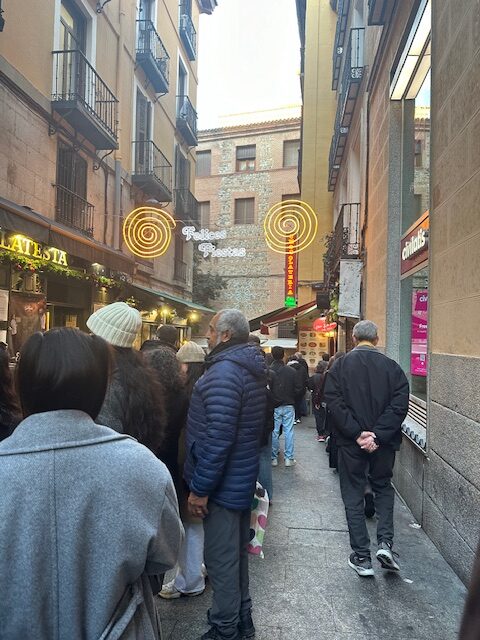
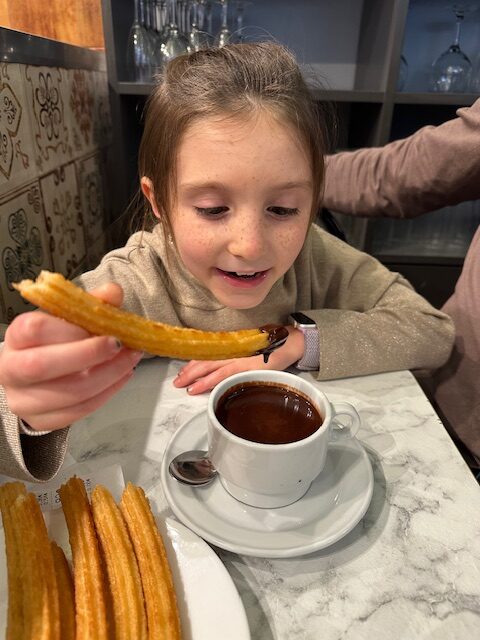
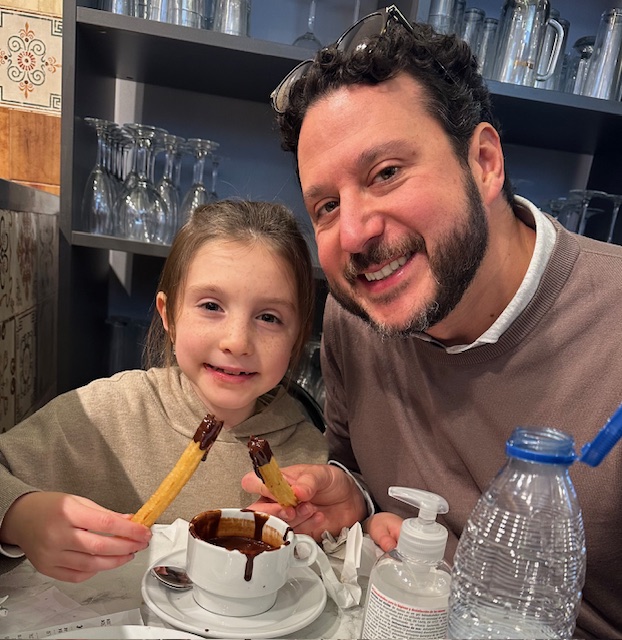
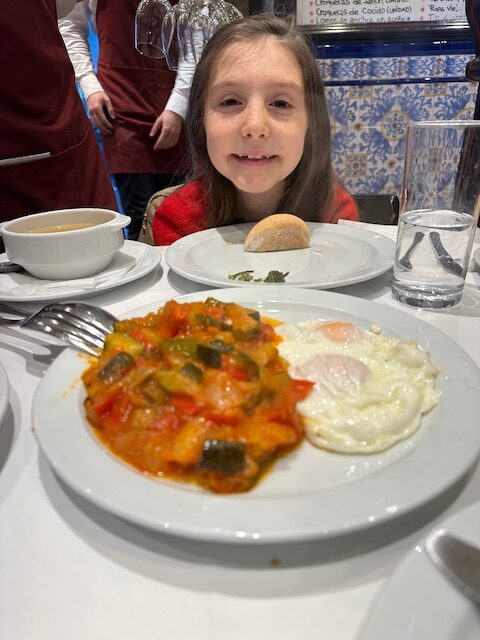
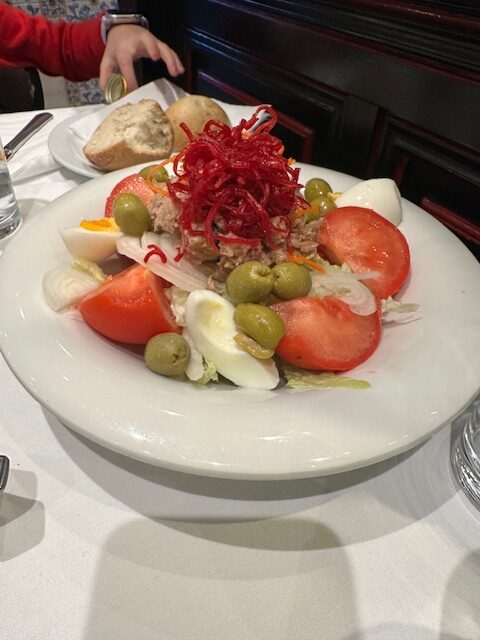

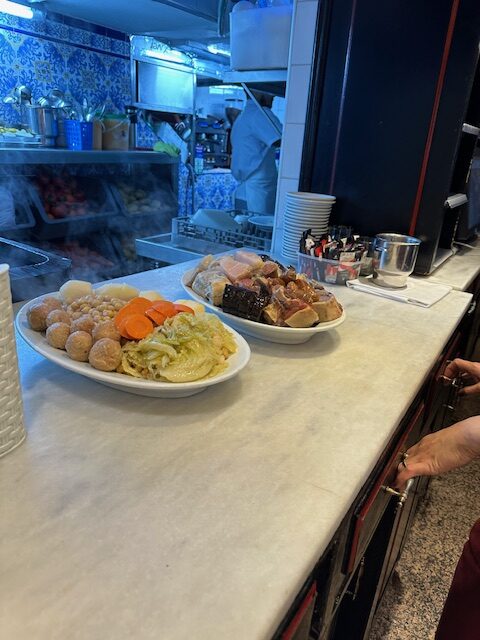
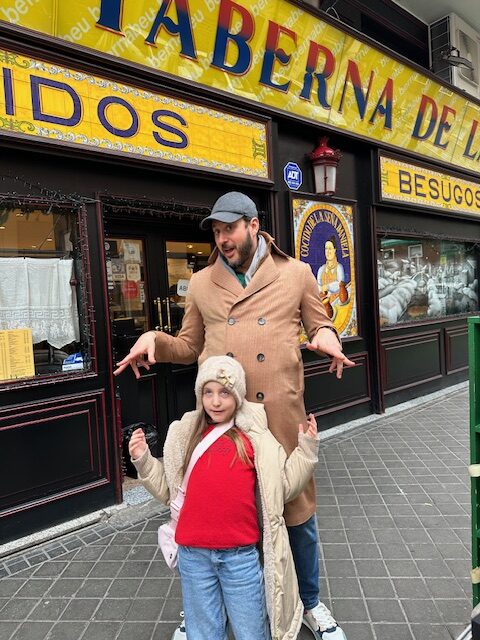
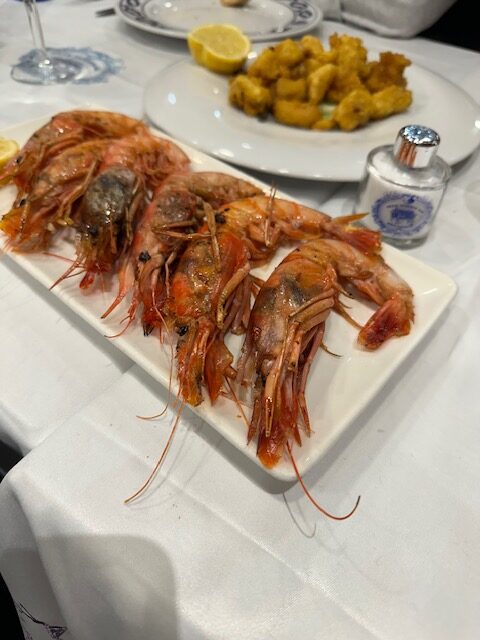
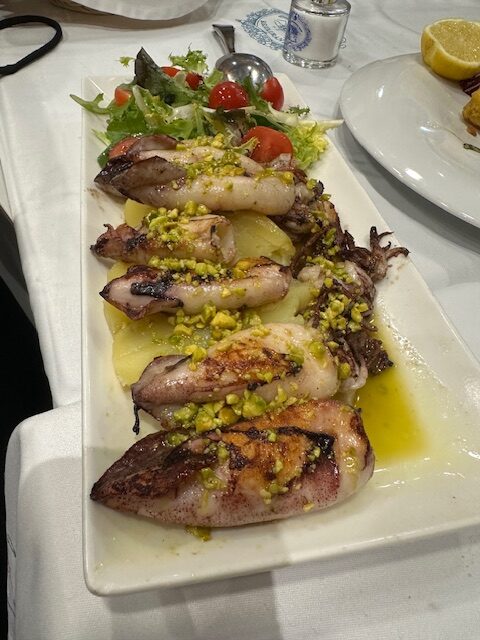


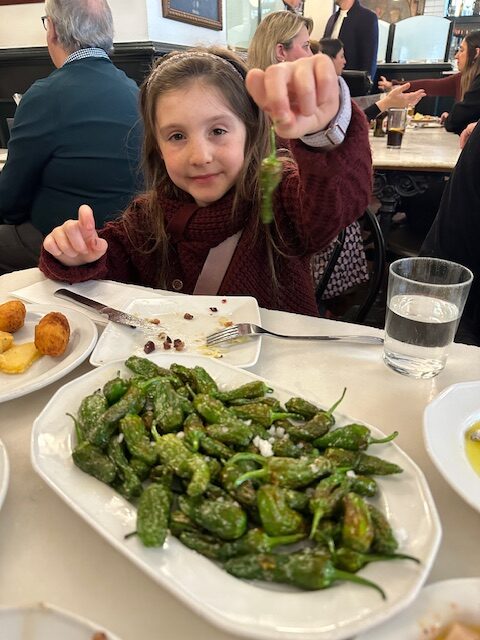
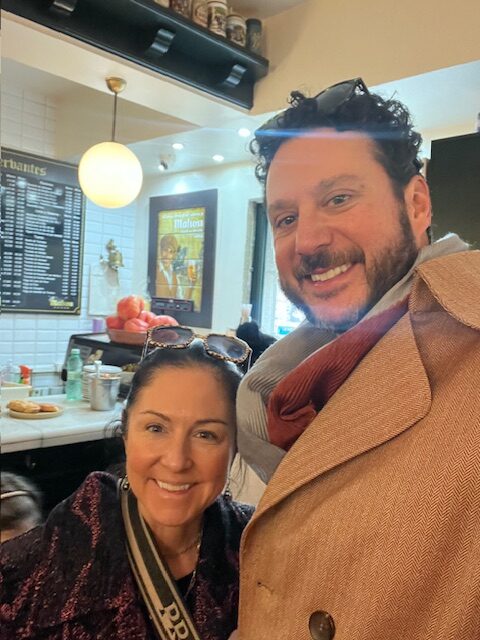
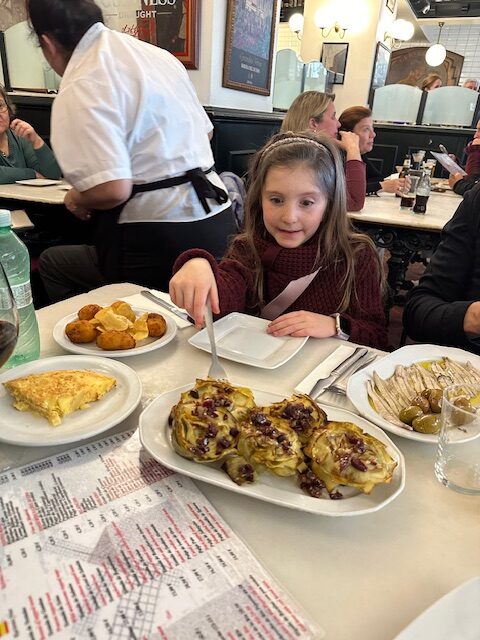
Madrid Dinner Recommendations: Winter 2024
1. La Maruca – We’ve been coming to La Maruca for a decade, at least. It just keeps getting better, and which is why it’s recently received a Michelin recommendation. La Maruca specializes in modern Cantabrian cuisine. Best known for its largest city, Santander, Cantabria lies on the Northern Atlantic coast of Spain. The seafood in Cantabria is some of the finest in the world. If you go to a seafood market in the region, the wide array of crustaceans, mollusks, and finned fish will amaze you. It’s hard to believe we accept such minimal variety in the U.S.
We made La Maruca our first dinner in Madrid because it’s reliable and lively, fashionable but not overly formal. And the food never disappoints.
Here’s what we ordered:
– Pimientos de Isla – assorted bell peppers, roasted to perfection and served simply with salt and their own juices
– Alcachofas en plancha – a peeled, trimmed artichoke, flattened and grilled, then served on a bed of onions and wild mushrooms, topped with a fried egg
– Merluza a la plancha – grilled hake, a fish we only have a skinny relative of in the United States. If you come to Spain, order merluza often. It’s a mild, hearty, delicious fish. I’ll go so far as to say it’s my very favorite fish,
– Cordero al horno – deboned lamb (I believe it’s the rib section), served with delectable, rich potatoes cooked in lamb fat
– Gin & Tonics, red wine
Don’t miss La Maruca – and make your reservation well in advance for roughly 9:30PM.
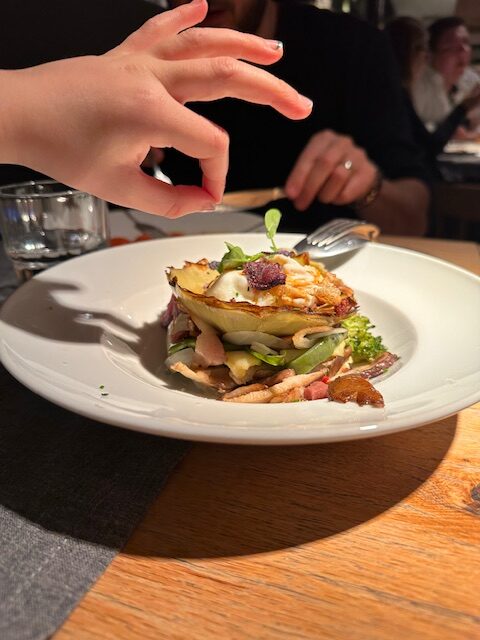
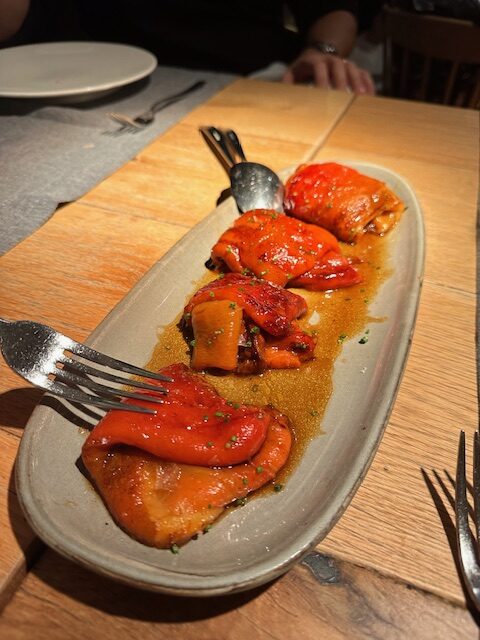

2. O’Grelo – I discovered O’Grelo on our last trip to Madrid through the Michelin guide, and it was so good that I knew we’d put it at the top of our list for the next Madrid dining agenda. As a bastion of Galician cuisine in Madrid, O’Grelo has an impressive host of seafood offerings, representing the wealth of shellfish and fish found along the Galician coastline (just north of Portugal). We saw several tables ordering beautiful, gigantic steaks, as well.
O’Grelo is a happening spot well into the late hours of the evening; diners commonly sit down after 11PM on the weekends.
Here’s what we ordered:
– Jamón Ibérico – hand-sliced Ibérico ham – the hand-slicing makes a giant difference, which is why I won’t buy it in the States from the machine-slicing cheaters. Super high-quality jamón here.
– Navajas a la plancha – grilled razor clams, my favorite mollusk. Razor clams are sweet and different from any other food I’ve ever tried. We can’t get them in Texas, so I go out of my way to order them whenever they’re on the menu.
– Fried boquerones – These are fresh anchovies. They’re cleaned, and their heads are removed, but the backbones and tails remain intact, adding not only a special crunch but also a ton of calcium!
– Caldo Gallego – A classic Galician stew that’s as culturally important as America’s apple pie. Josephine loves soup, so if there’s ever a good one on the menu, I make sure to order it for her. A great soup will redeem even a mediocre meal for her. This one is hearty because of its chorizo base, but it’s also heavy on vegetables, like turnips, kale, and potatoes, so my veggie-loving daughter is a fan.
– Arroz con pulpo y almejas –Just as Italians have their risotto, Spaniards have their own approach to rice. In Spain, they never add dairy or cheese to rice (or, at least, not that I’ve seen). Instead, they invest in the broth, making a rich, colorful, flavorful foundation to turn plain rice grains into pure goodness. At O’Grelo, most of the rice dishes capitalize on so we went with a seafood-based rice that incorporated two of our favorite ingredients: octopus and clams
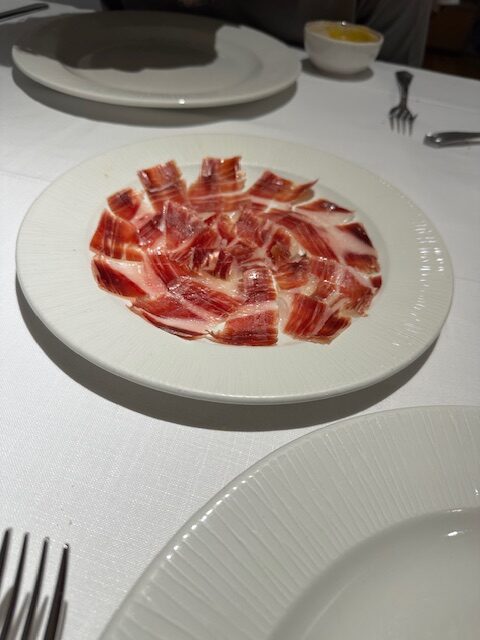
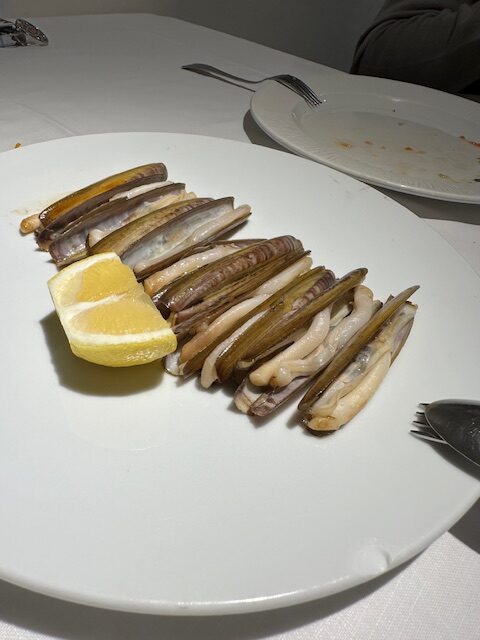

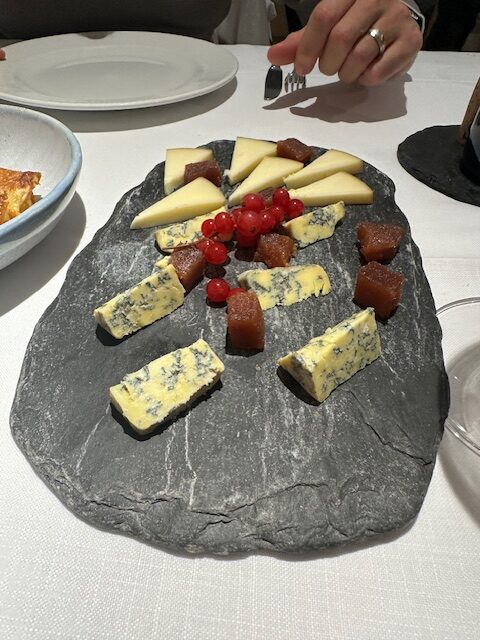
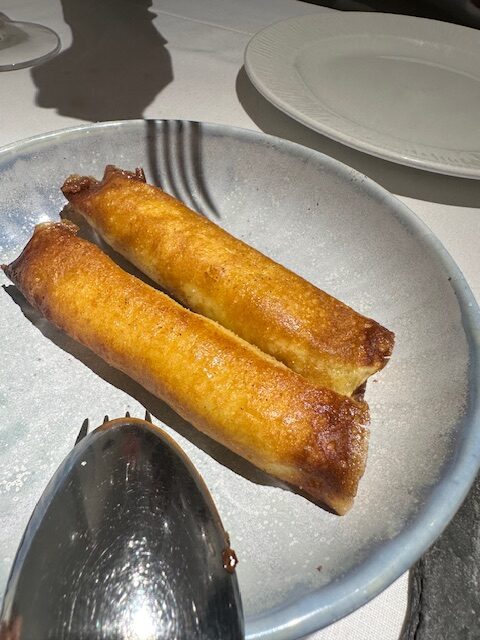
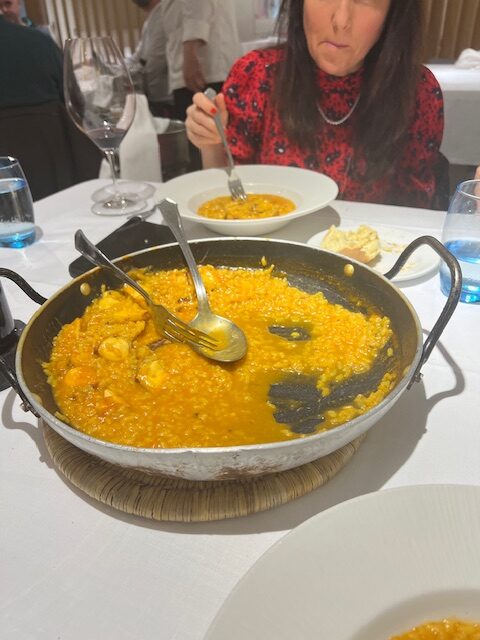
3. El Landó – I probably don’t need to discuss El Landó. I’ve written about it before. But I just can’t stop myself. The restaurant is an institution, popular with Madrileños and foreigners alike. It’s super old-school, super Spanish, and super special. Easily one of my favorite restaurants in the world. At El Landó, we always get the huevos estrellados, sunny side up eggs over French fries, cut and tossed together at the table to envelop the crispy potatoes in velvety eggs. It’s outrageously delectable. We follow that with the perfectly cooked churrasco cut of steak, which serves two people. Since Josephine started coming with us, we’ve also added the beef consommé to our regular rotation; she could eat a vat of the crystal-clear broth. If you come, you also need to get the bandeja de tomates, which is a paper-thin layer of tomatoes, flavored ever so slightly with garlic, salt, and olive oil. AND you must get the jamón with the pan de cristal. Pan de cristal is essentially pan con tomate, but the bread is super thin and crunchy, so it breaks like crystal in your mouth. El Landó is worth traveling all the way to Spain for. You’ll get the same waiters that have been there for decades, order a bottle of the trusty house-labeled wine, and have a meal you’ll be talking about until the next time you get to descend the wooden staircase into the darkly paneled comedor, filled with white tablecloths and white-tablecloth service.
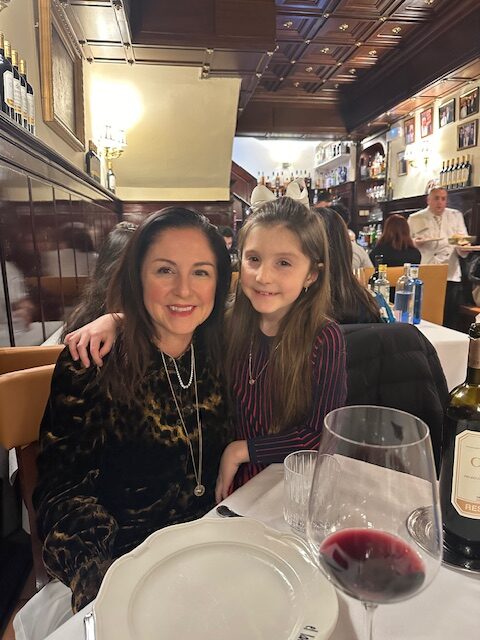
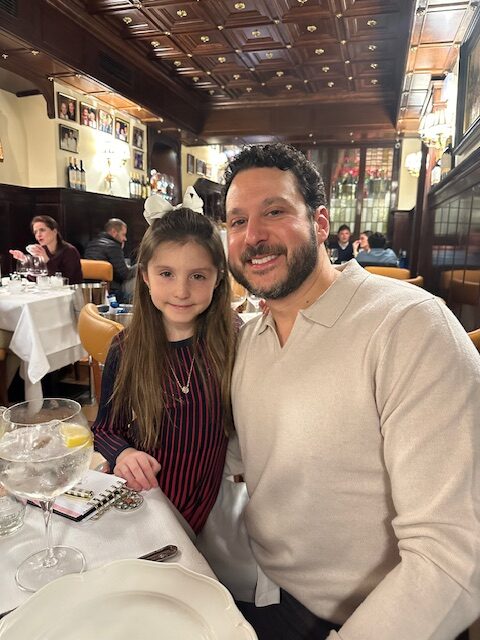
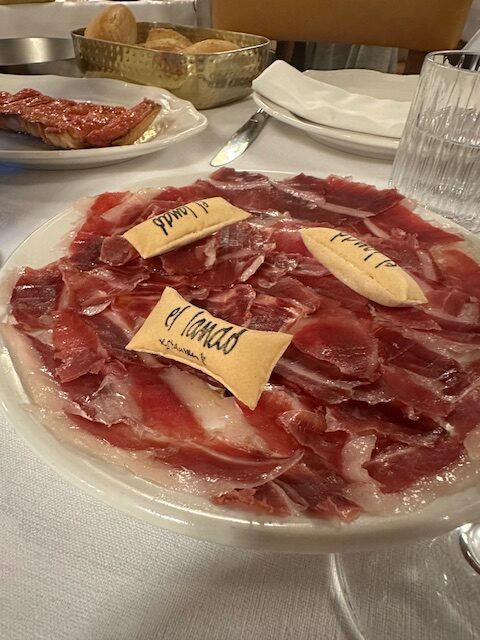
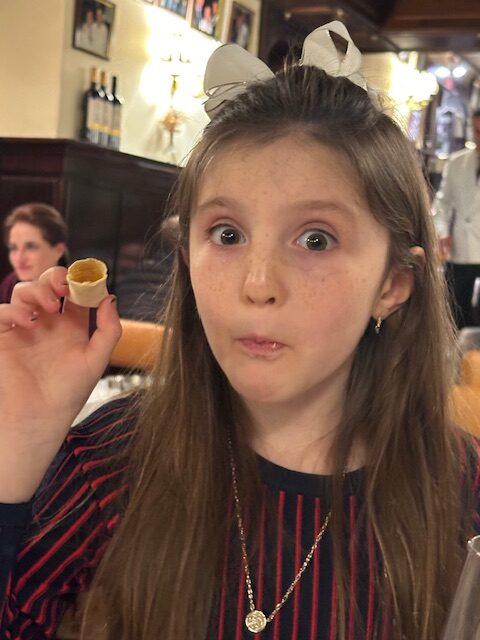
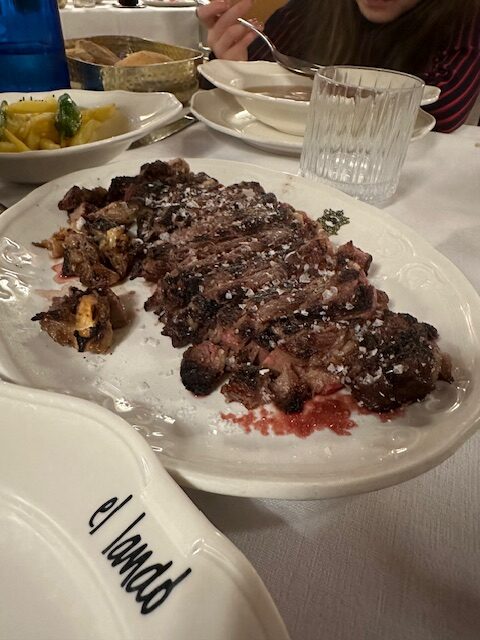

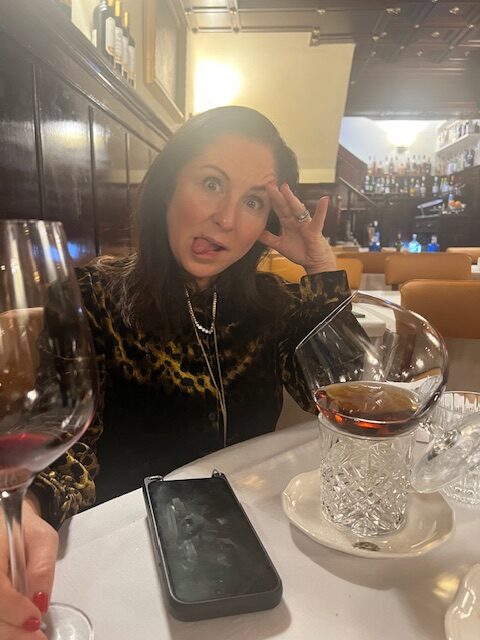
4. Las Tortillas de Gabino – We just tried this restaurant for the first time on our most recent trip to Madrid, drawn by the novel takes on the humble tortilla (FYI in Spain, a tortilla bears no resemblance to the ones served in Mexican establishments; it’s a delicious dish unto itself, comprised of diced or thinly sliced potatoes, olive oil, and eggs). At Las Tortillas de Gabino, the standard tortilla Española is dressed up a bit, with toppings like pulpo a la Gallega (a traditional, simple octopus steamed with paprika) and gambas con salsa picantita de tomates (shrimp with a spicy tomato sauce). We chose the tortilla with truffles because I can’t resist a truffle. It was good, but I think I’ll go with something different next time, something with tomatoes or seafood. What I will order again are the lentejas estofadas (stewed lentils). They were insane. And I would get the presa Ibérica again – a beautiful pork loin, seared to a perfect medium rare and served with gorgeous wild mushrooms. What’s not to love?
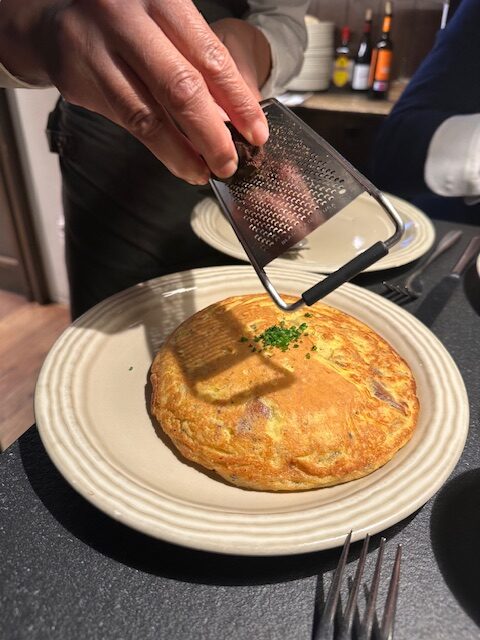
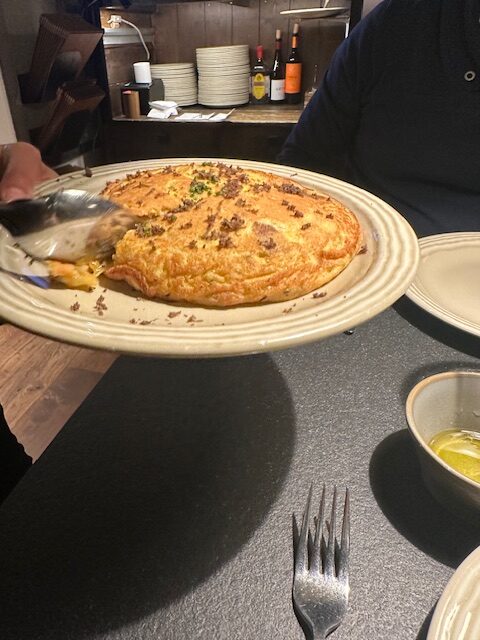
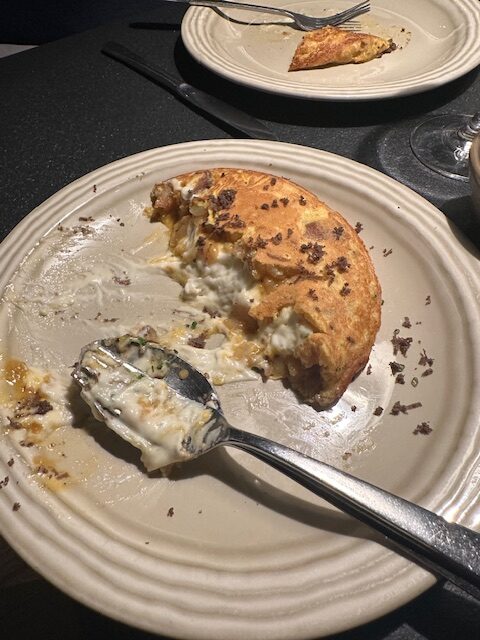
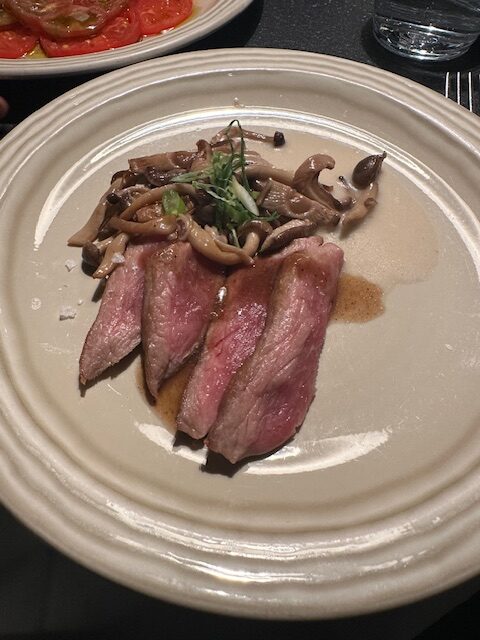
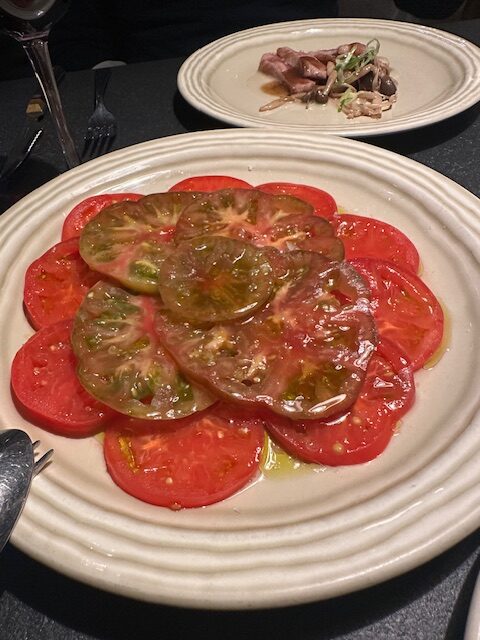
5. Sottosopra – Late on January 1, we wandered into Sottosopra, an Italian restaurant located in a hip little enclave off Calle Jorge Juan in Barrio Salamanca. I hadn’t made a reservation, which is unlike me, but I didn’t know how we’d be feeling after a hefty New Year’s lunch. As it turned out, we were all hungry (of course, we were – it was 10:15PM!), and I knew Josephine might welcome the chance to eat some pasta. Sottosopra turned out to be the perfect choice. The pasta with truffles was great, as was the grilled octopus, and the service was delightful, especially given the fact that we walked in basically at closing. I now understand why this place is always crowded, and we will definitely be back. It was so good, we totally forgot to take pictures this time.
Fun, Simple Experiences for Families Visiting London
On this last trip, we decided to stay at the Peninsula Hotel, located in Belgravia. We’d never stayed in Belgravia before; we normally opt for the Mayfair area, wonderful for shopping and fun restaurants, or Knightsbridge, if we want to be close to Harrod’s and the Victoria & Albert Museum. But time and again, I’ve driven by the Peninsula and heard of Belgravia, so we decided to give it a go.
As you might expect, the hotel was awesome. Peninsulas usually are. But what was even cooler than the hotel itself was the location. We were right by the Wellington Arch, where pillars engraved with the names of England’s territories line the way and which leads to Green Park.
The first morning we were there, we stumbled upon a group of people who were tossing crackers to the birds in the trees. The birds actually landed in the people’s outstretched hands and perched calmly. Josephine was mesmerized, especially because a few of the birds looked like miniature parrots (perhaps escaped pets??). She, of course, had to feed the birds, too. Thankfully, those sweet strangers shared their biscuits and nuts to lure the birds and squirrels Josephine’s way.
It’s often unexpected, simple activities, like tempting park wildlife to eat out of our palms, that make our trips memorable. So I think we’ll stay there again and come prepared with a pile of oyster crackers to attract all the runaway parrots we can.
Fortnum & Mason’s
We also had a wonderful experience visiting Fortnum & Mason’s. Fortnum & Mason’s is by far one of my favorite department stores in the world, rivaling Mitsukoshi in Tokyo. Actually, it’s more like a shopping amusement park. Every level is something more magnificent than the last. Walking in on the first floor, you’re immediately shocked by the vibrant display of marzipans and other luxury candies. In the basement, you can wander through their grocery selection, including the most gorgeous pork chops I’ve ever seen, phenomenal mustards and jams, etc. Then, upstairs, you have levels with wonderful home goods, like unusual China patterns and luxurious wrapping paper; clothing and accessories, showcasing fabulous designers you’ve never heard of; a fabulous bar with velvet couches and great cocktails. The list goes on and on. And to make it even better, Fortnum’s creates beautiful, wildly decorated window displays, which make it a treat just to go in and out the front door! Josephine adores the entire experience, and I always let her pick something out – last time, marzipan; this time, a headband – so she’ll have something to remember our magical time gawking at F&M’s wares.
Even if you don’t venture inside F&M, I recommend that you just walk past the window displays, which are impressive enough to warrant a visit on their own.
The Shopping Arcades
While near F&M, we also found ourselves checking out London’s shopping arcades. Arcades in the US are generally associated with Pac-Man and Mortal Kombat. But in London, an arcade is a long hallway with arched entryways and ceilings, lined on both sides with beautiful shops. We rarely enter the shops because they’re quite pricey – and because it’s always awkward entering a tiny shop, where you’re the center of the salesperson’s attention. However, this time, Josephine desperately wanted to go into the Faberge boutique. I don’t know where she learned about Faberge eggs, but she’s obsessed. Anyway, the gentlemen in the Faberge store were so sweet. They let Josephine try on various jewelry, although they had to know there was no way I would be buying her a begemmed 18-karat gold egg pendant.
I’ve been trying to make those silly stops with Josephine, walking into gorgeous shops even when we have no intention of buying anything. It just makes the world more fun. – however, the Faberge salesman can stop contacting me because we’re not really in the market for wearable eggs.
The Dickens Museum
I confess, I’m not a huge Dickens fan. Every Dickens book I’ve tried to read has put me to sleep. However, I do love A Christmas Carol, even if I prefer the stage to the page. And I’m kind of a sucker for historical figures’ former homes – Monticello, Mount Vernon, the House of Augustus, Hadrian’s Villa. The list really goes on and on. Why not add Dickens’ London townhouse to the mix?
The museum was cool, as it turned out. We got there about 45 minutes before closing (par for the course with this crew), so we didn’t linger. But there was no need. We got to see all the rooms of the house, including the study where Dickens wrote a masterpiece or twelve. And we got to see a Victorian-era kitchen and a Victorian-era toilet… And we learned that Dickens’s dad went to prison and left the family dirt-poor. It’s amazing that he became one of the most prolific, well-recognized authors in the English language.
Okay, it wasn’t exactly scintillating, so I wouldn’t recommend it to people seeing London for the first time, but we come often enough that it was worth a visit.
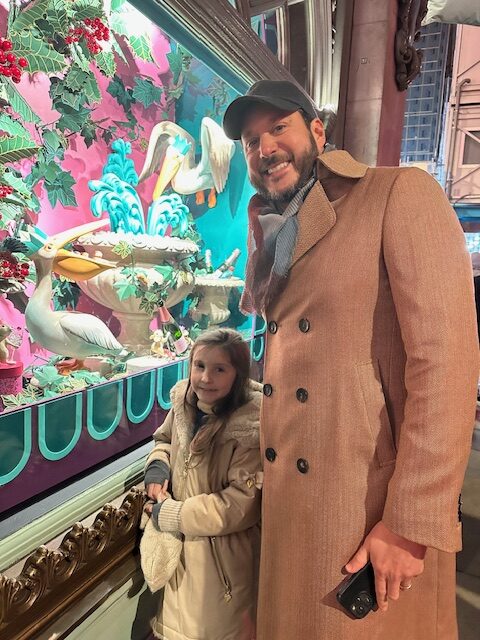

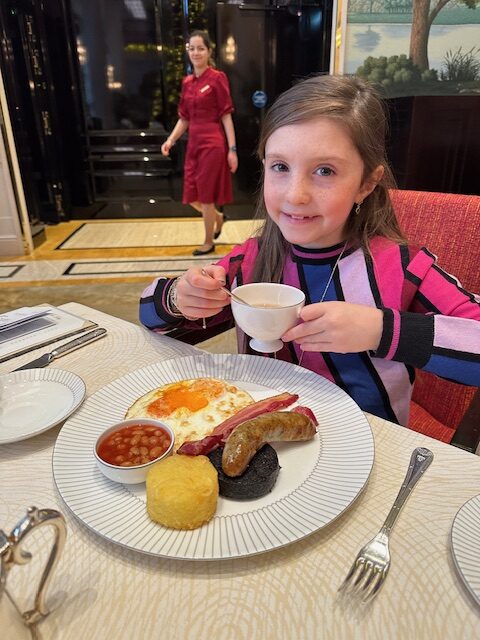
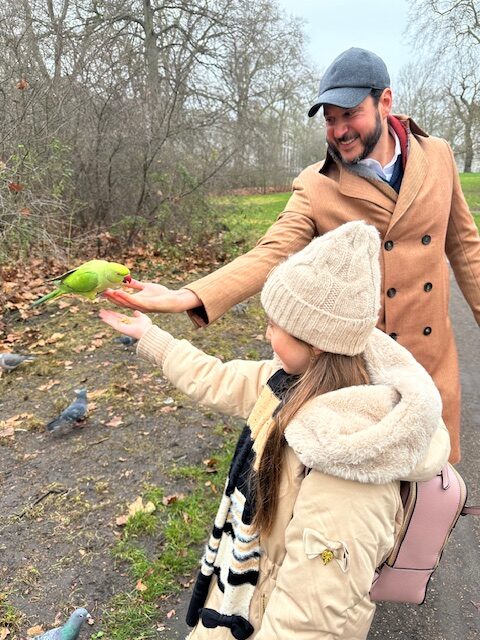
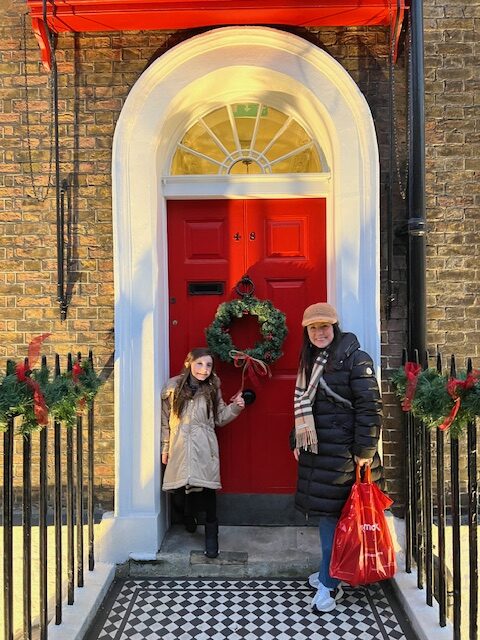


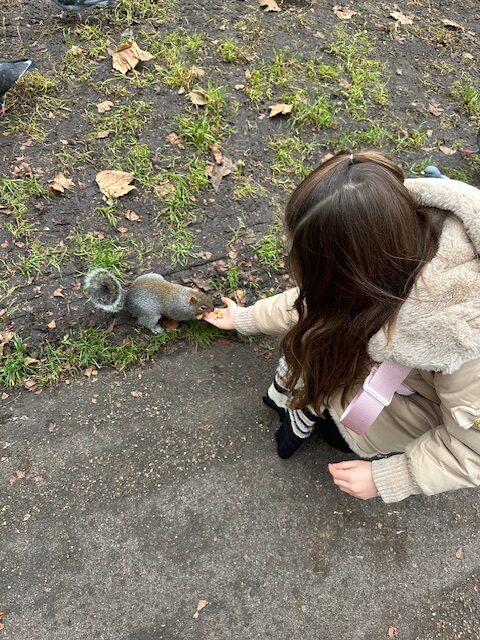
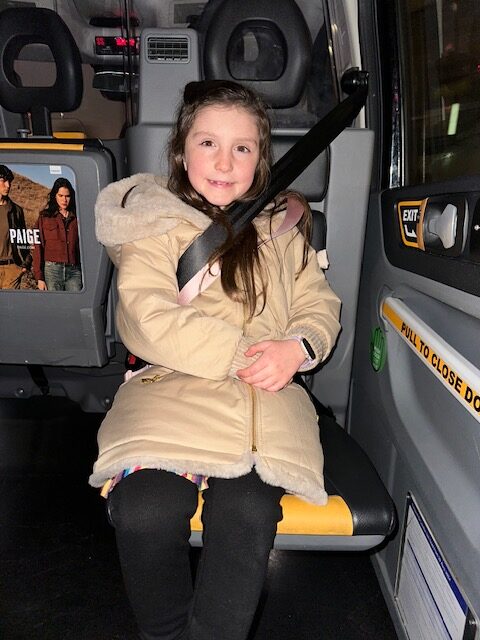
A Doozy Plunge into the Abrasions of Travel
It’s no secret, Jamil and I have traveled throughout much of the world. Here and there, airlines have forgotten one of our bags, creating a bit of uncomfortable but manageable strife.
For example, United misplaced a bag containing Josephine’s car seat and our winter coats when she was about 4 months old; we wandered around Rome and bought some substitute goods but received the bag before the road trip through the countryside began. And just recently, United left my bag in Houston on our trip to Washington, DC. Thanks to the modern bag tracking system, we could easily see that the bag had been put on the next flight and would arrive later in the afternoon. No big deal at all!
None of that prepared us for the chaos that ensued when Iberia misplaced ALL FIVE of our bags. Yes, I said five. Yes, we pack a lot — probably too much, but who can tell it’s too much until the trip is over and you can see what you didn’t wear? In any case, not a single bag made it with us to Madrid.
Before we left, Jamil put new batteries in our AirTags and made sure every bag had an AirTag. Consequently, when we landed in Madrid, we could see clearly that the bags were nestled in a corner at London Gatwick. We presumed Iberia would do just what United did: stick it on the next flight out, which would leave in just a few hours. We’d have to go a little while — possibly overnight, without our gear — but nothing earth shattering.
We went blithely to the customer service counter in the airport, expecting them to confirm that the bags had never left London. However, Iberia said the bags had made it to Madrid. And it soon became clear that they had no tracking data whatsoever. When I showed them that the AirTags were in London, they tried to convince me that the AirTags were imprecise; the bags had yet to be located but would likely show up in the next (get this!) 72 hours! They told me to check the online system for updates and to purchase necessities until our five bags were found.
We left perplexed because we knew exactly where the bags were. That night, I barely slept because I was so worried that our bags would fall into some luggage abyss somewhere, and we’d never see our things again. In the middle of the night, Jamil and I determined that we had to take matters into our own hands. We bought a ticket for Jamil to fly to London in the morning and collect the bags.
When he got to London, Jamil learned that the bags were indeed sitting on the tarmac, and the Iberia/British Airways personnel put the bags on his return flight. They assured him he wouldn’t need new baggage tags; the bags would just arrive on the carousel when he got to baggage claim. As you might guess, they did not. However, we could see that they’d made it to Madrid, so we went over to the customer service counter again. And again, they had no idea where the bags were. They didn’t show that the bags ever left London, but they also didn’t show that the bags were even in London. They truly knew nothing at all.
When I asked them to find the bags, they said they were in a machine where no one could see or access them. They didn’t know when they’d pop up again – they said to expect at least 72 more hours. I was floored. It had already been 24 hours! AND THE BAGS WERE AT THE AIRPORT, RIGHT BY WHERE WE STOOD. It was absurd.
For five days, we went daily to the Iberia customer service counter in the baggage claim area of the Madrid airport. For five days, they told me by phone and in person that the search for our bags was continuing. For five days, we went and purchased new clothes, toiletries, and so forth to get through our daily sightseeing activities and our evening dinner plans (including an elegant New Year’s Eve party). Somewhere in there, they concluded that the team in London had retagged the bags but had not entered the new data in the airline’s tracking system, so no one could offer any timeline to expect the bags’ return. It would take almost six days to get them back.
I don’t want to get bogged down in any more painstaking detail, but let me share what I learned through this process:
1. Very little gets accomplished by phone; the people in call centers have delayed information, at best. You actually have to go in and harass people at the airport.
2. You have to use all available clues to piece together the location of your bags. (We got the numbers off the second bag they located and practically forced the lady at the counter to seek out related numbers.)
3. You cannot take no for an answer when you know your bags are within reach.
Overall, we were fortunate that this bag mishap occurred in Madrid. We’ve spent countless days there, so we didn’t have any sights we were desperate to see. But we certainly didn’t want to spend 4-6 hours of each day fighting to get our luggage back, which is what we had to do.
And as a side note, Iberia’s system still doesn’t show that we’ve gotten our luggage. It shows that the search continues for two of the five bags, and it shows that one other has been located but not confirmed. It is wild that their system is so unreliable. I can promise you that I won’t be flying Iberia again with bags any time soon.
I’m also going to try to modify my overall packing strategy. I’m not going to take clothes or shoes that I absolutely love anymore. In fact, I may buy some super-cool travel items with the idea in mind that I might lose them. Additionally, I’m going to pack a small kit of essentials in my carry-on; I’ll put things like extra contact lenses, face wash, moisturizer, underwear, socks, etc., in there, just to have some tide-me-overs if my luggage gets misplaced again. That won’t see me through multiple days without my gear, but it’ll be a decent start.
Copyright 2022 , All-in-One Academics
info@allinoneacademics.com
